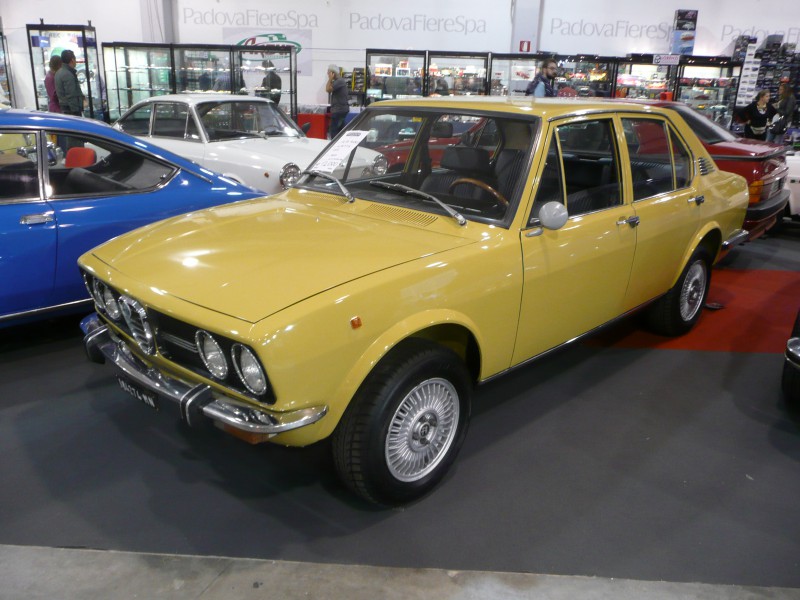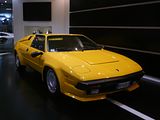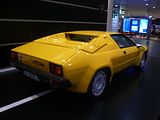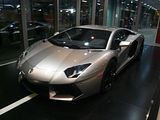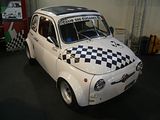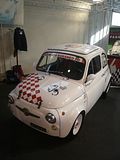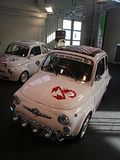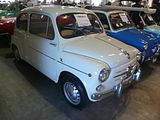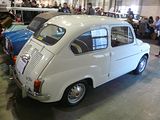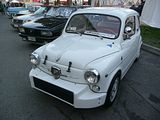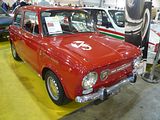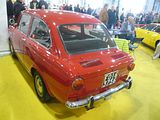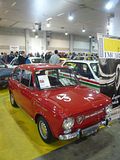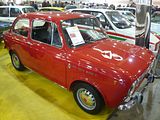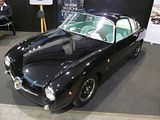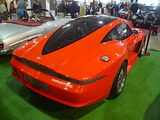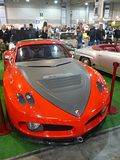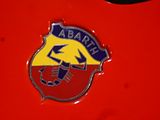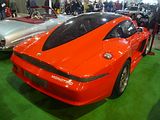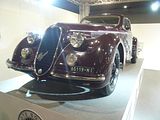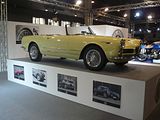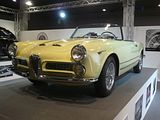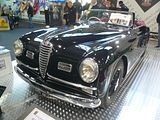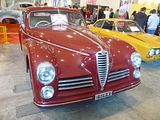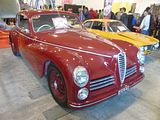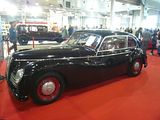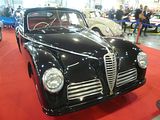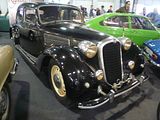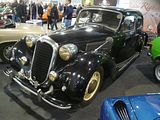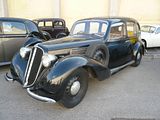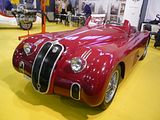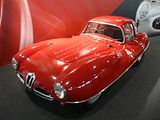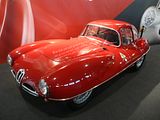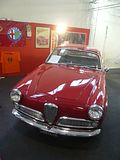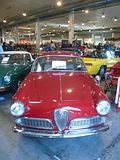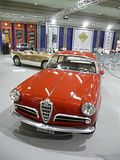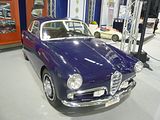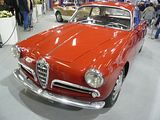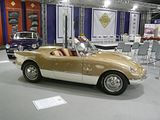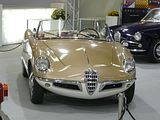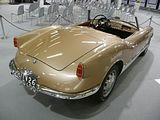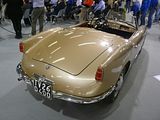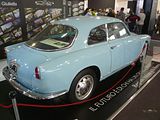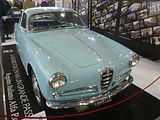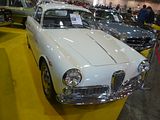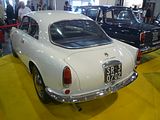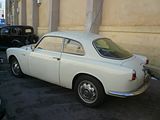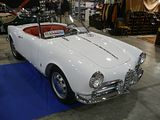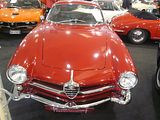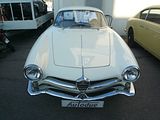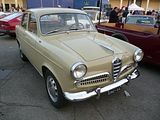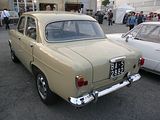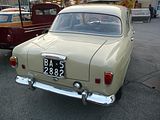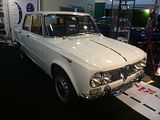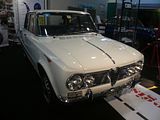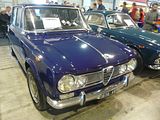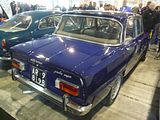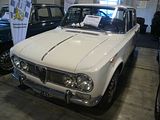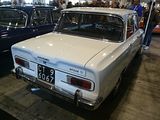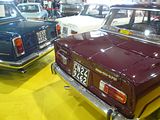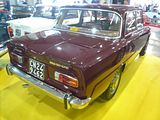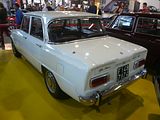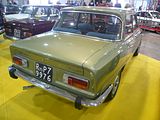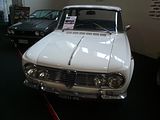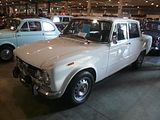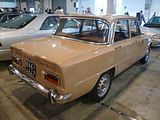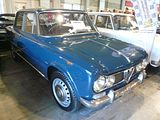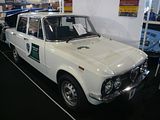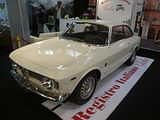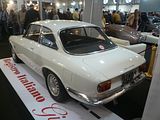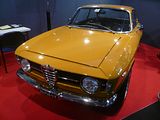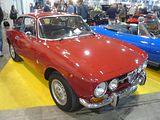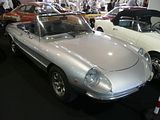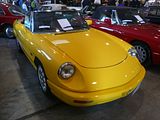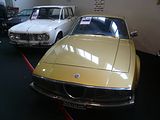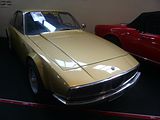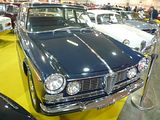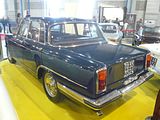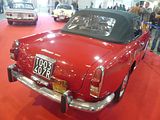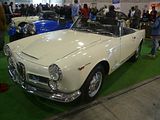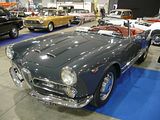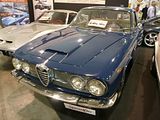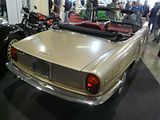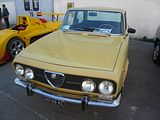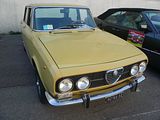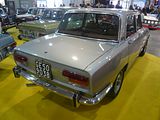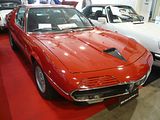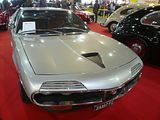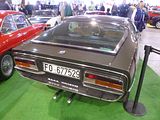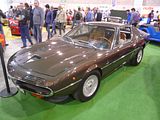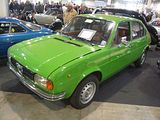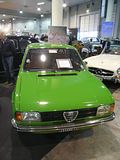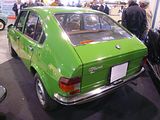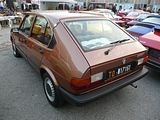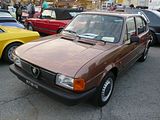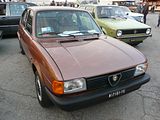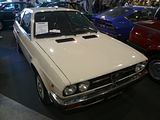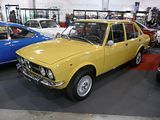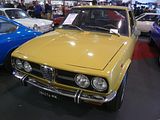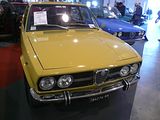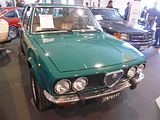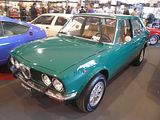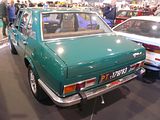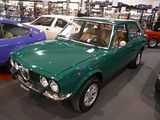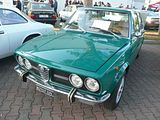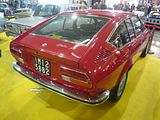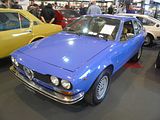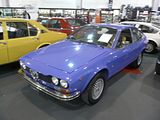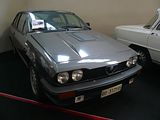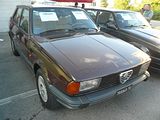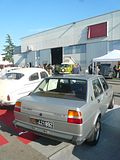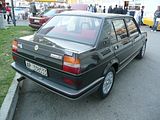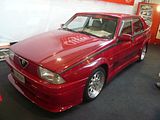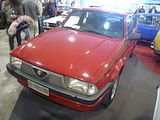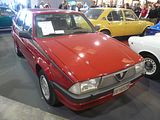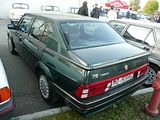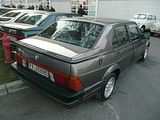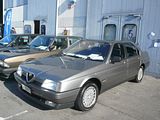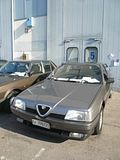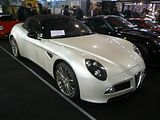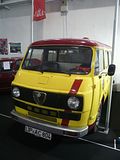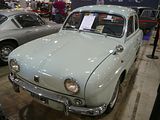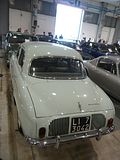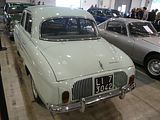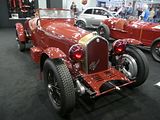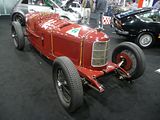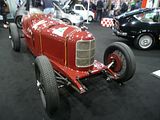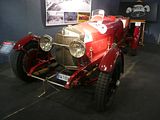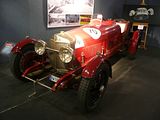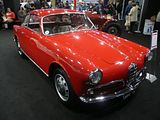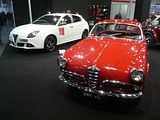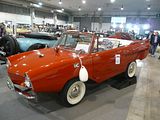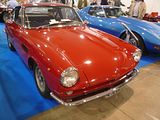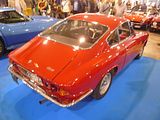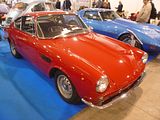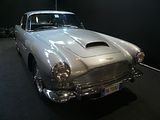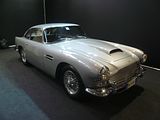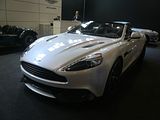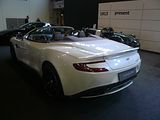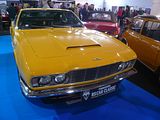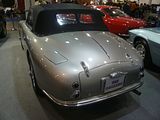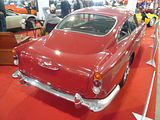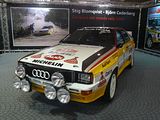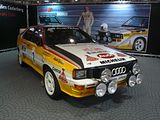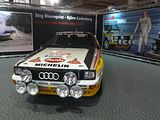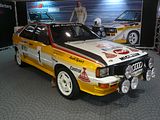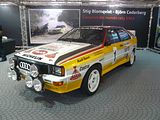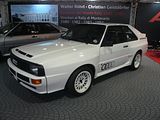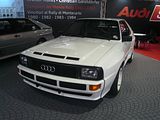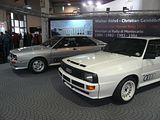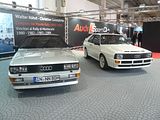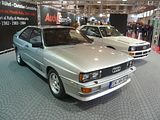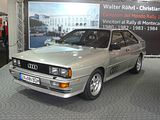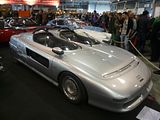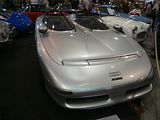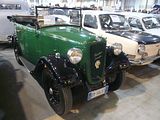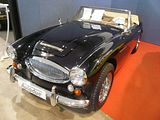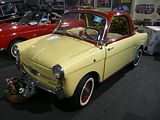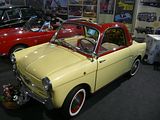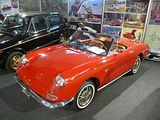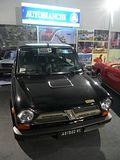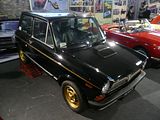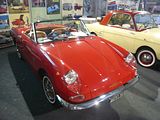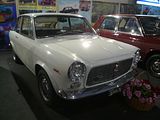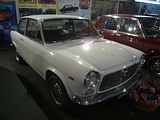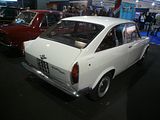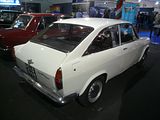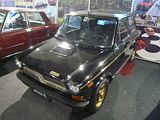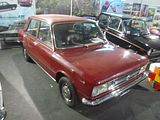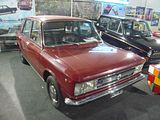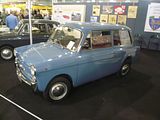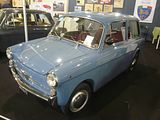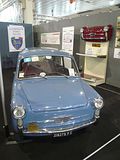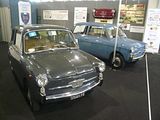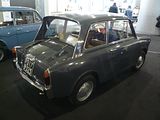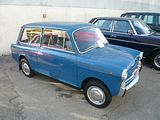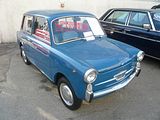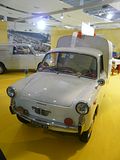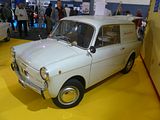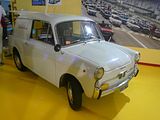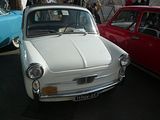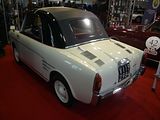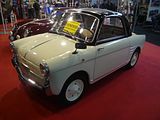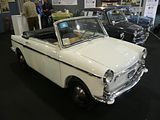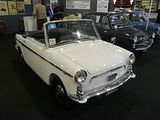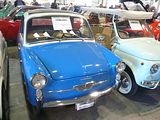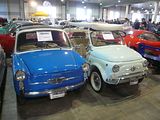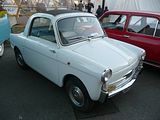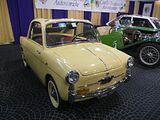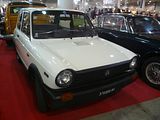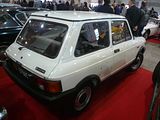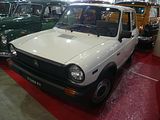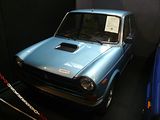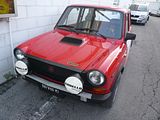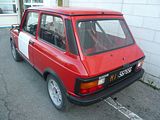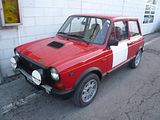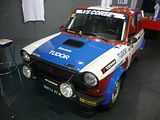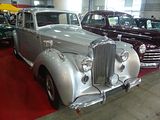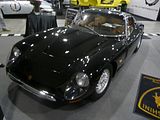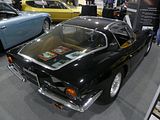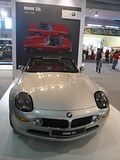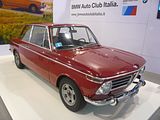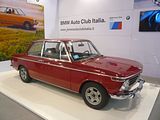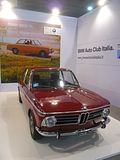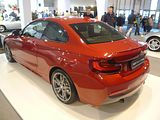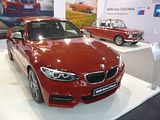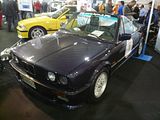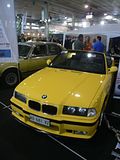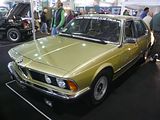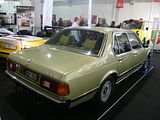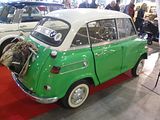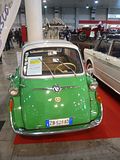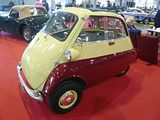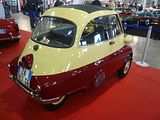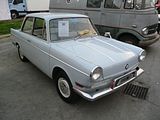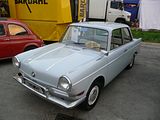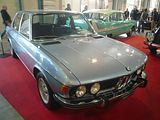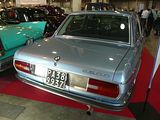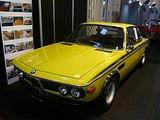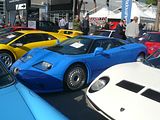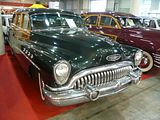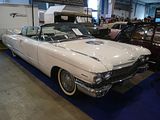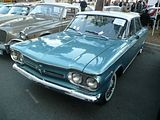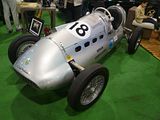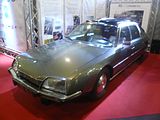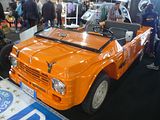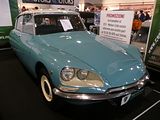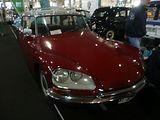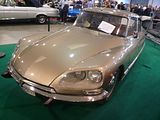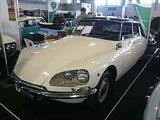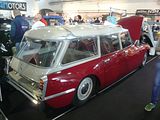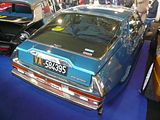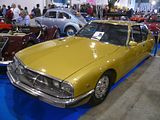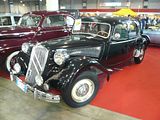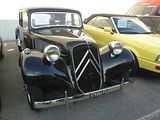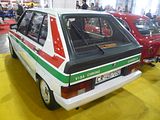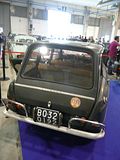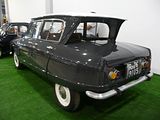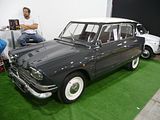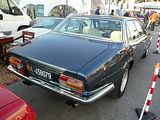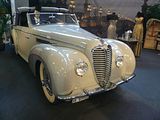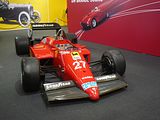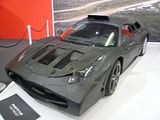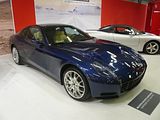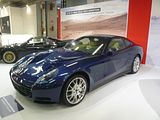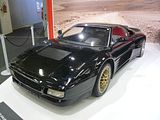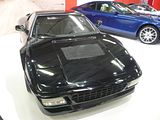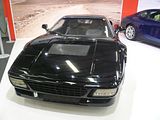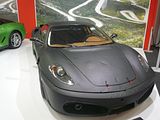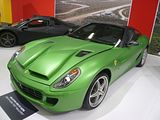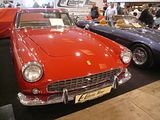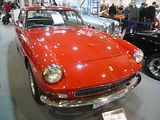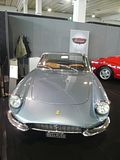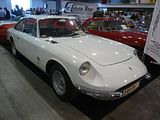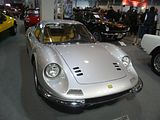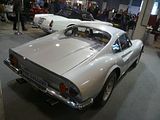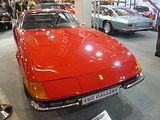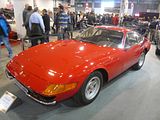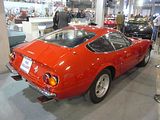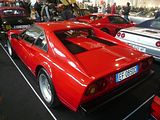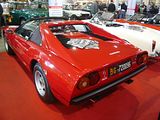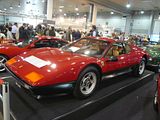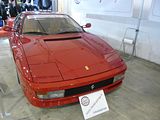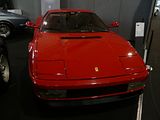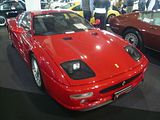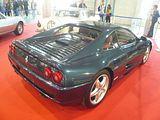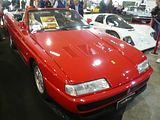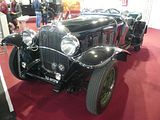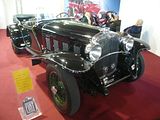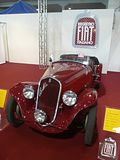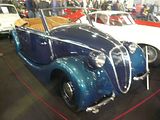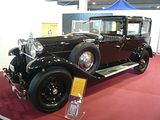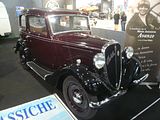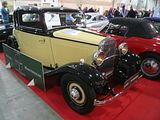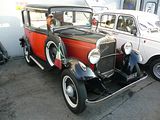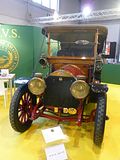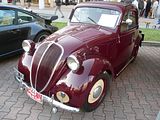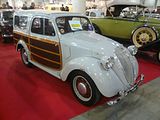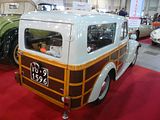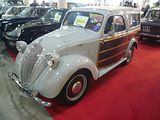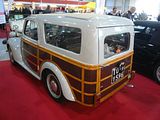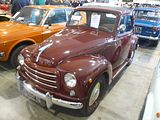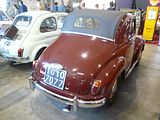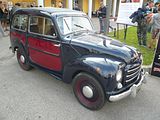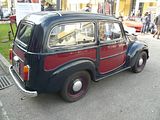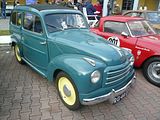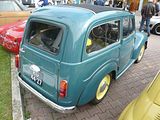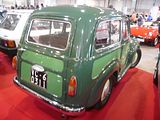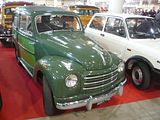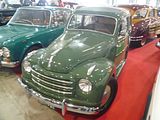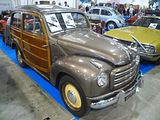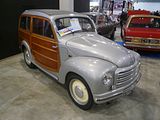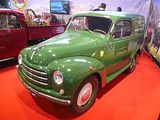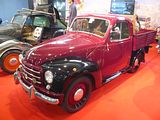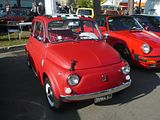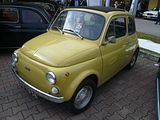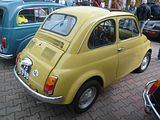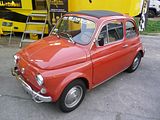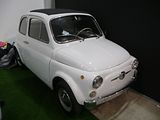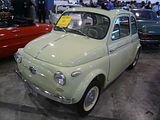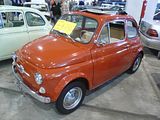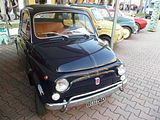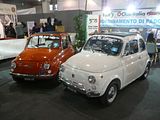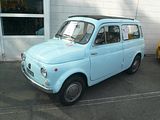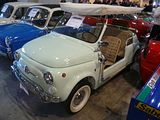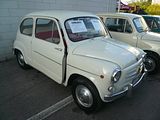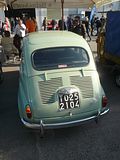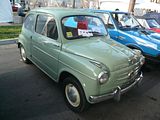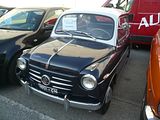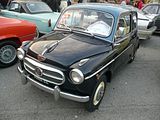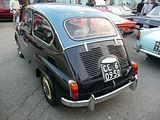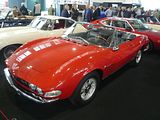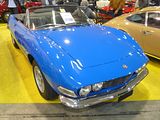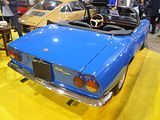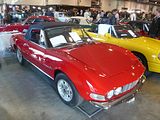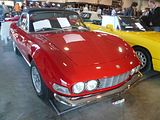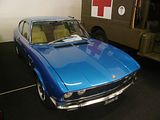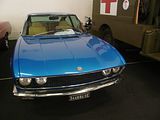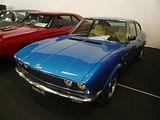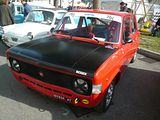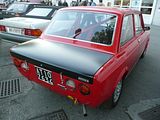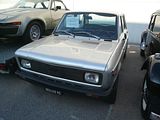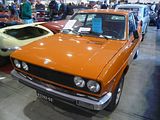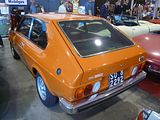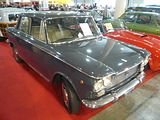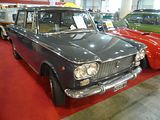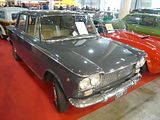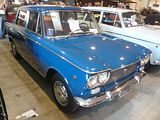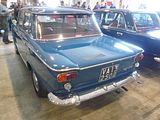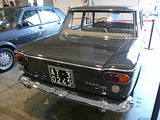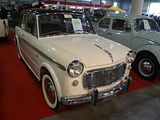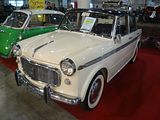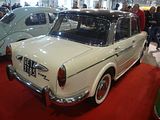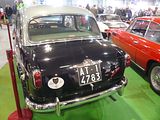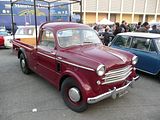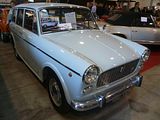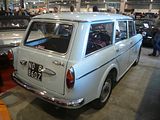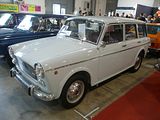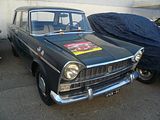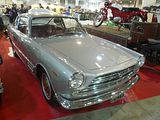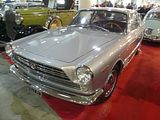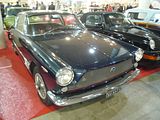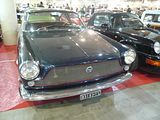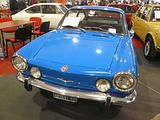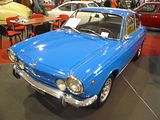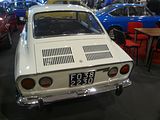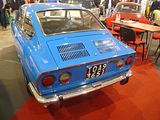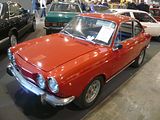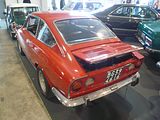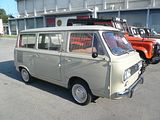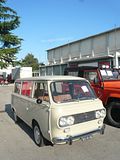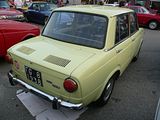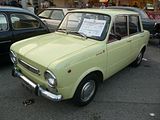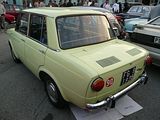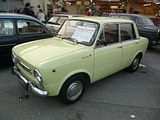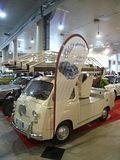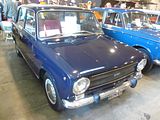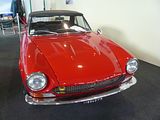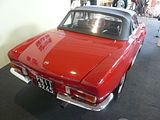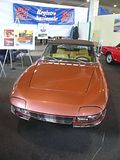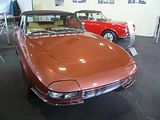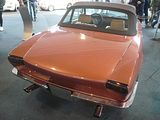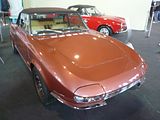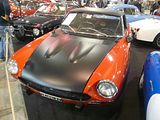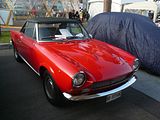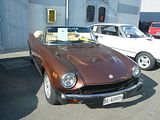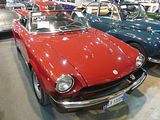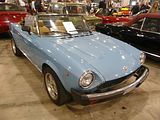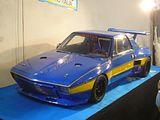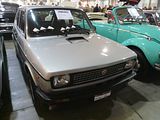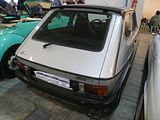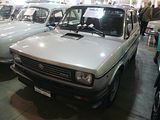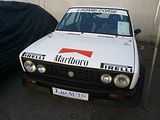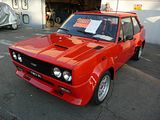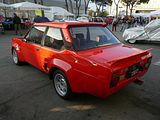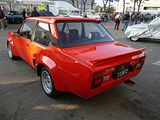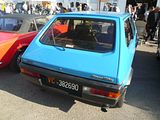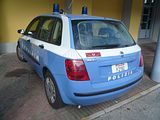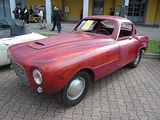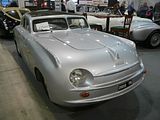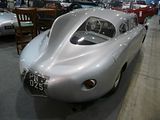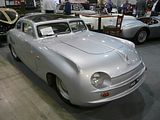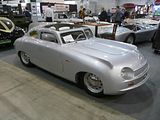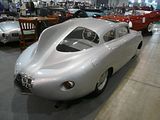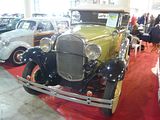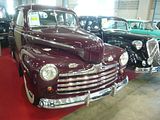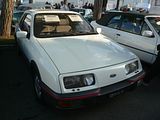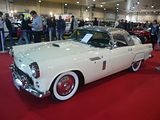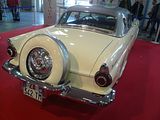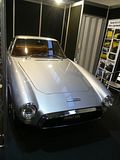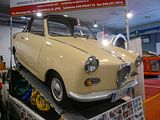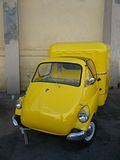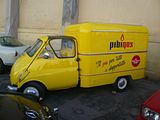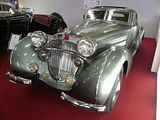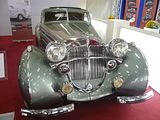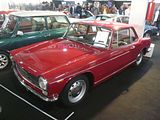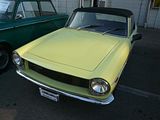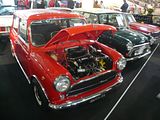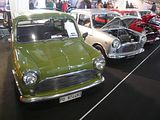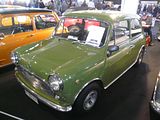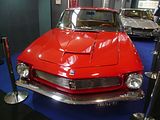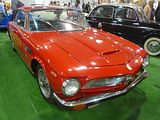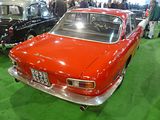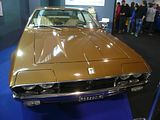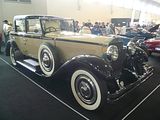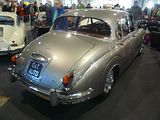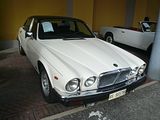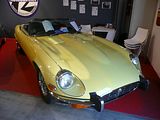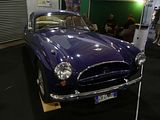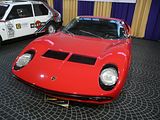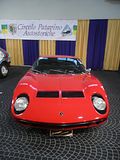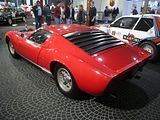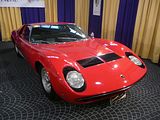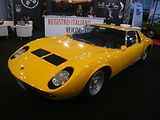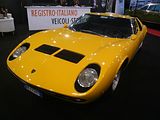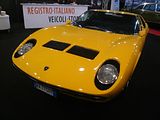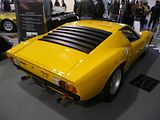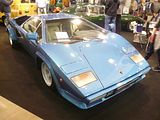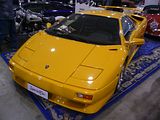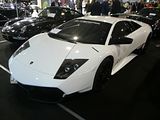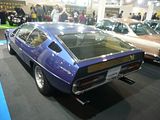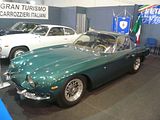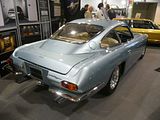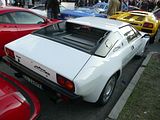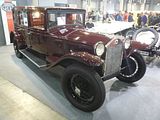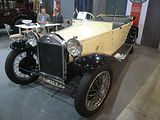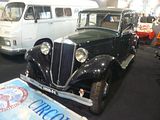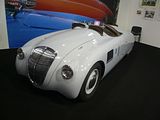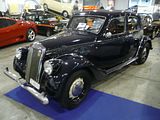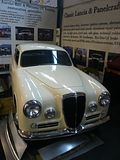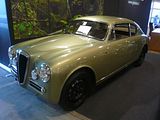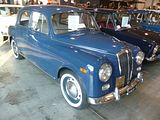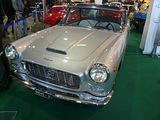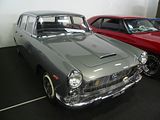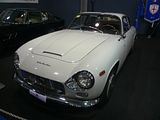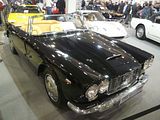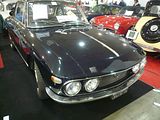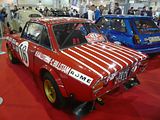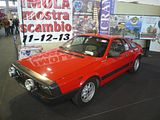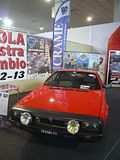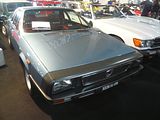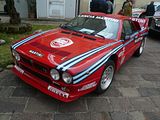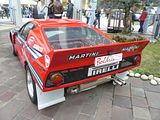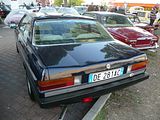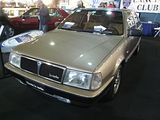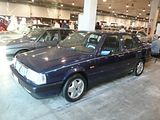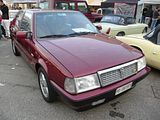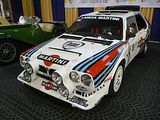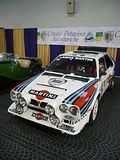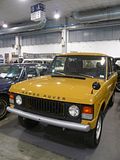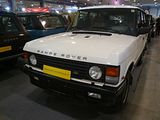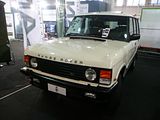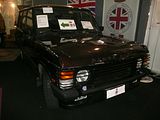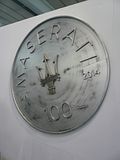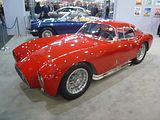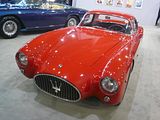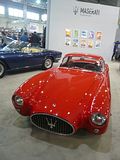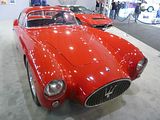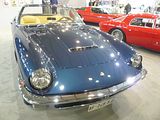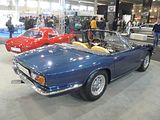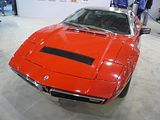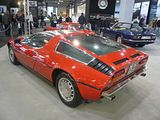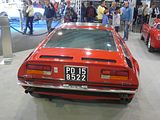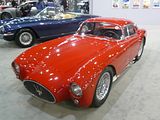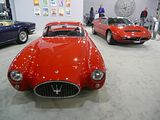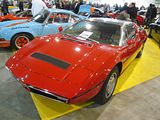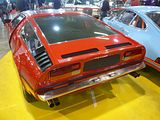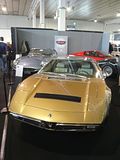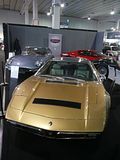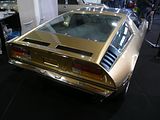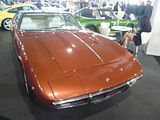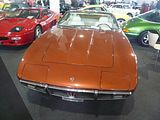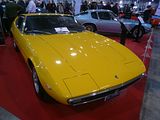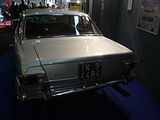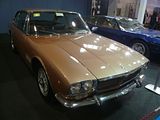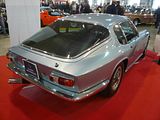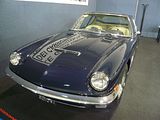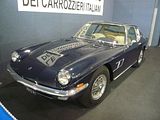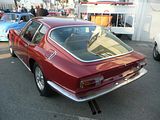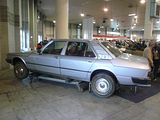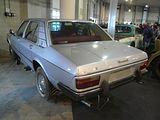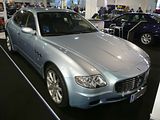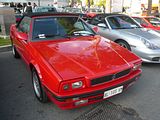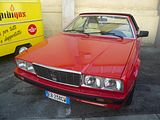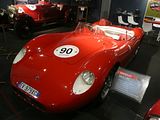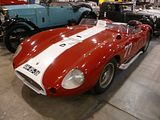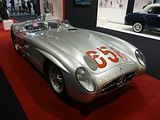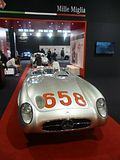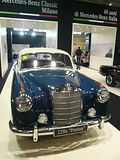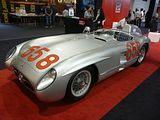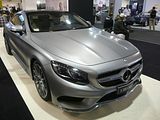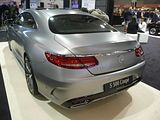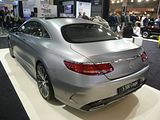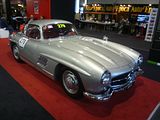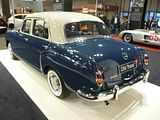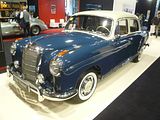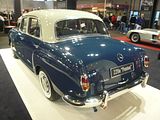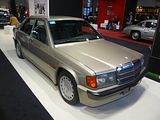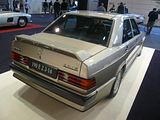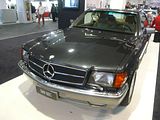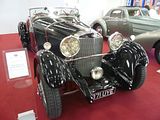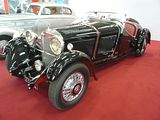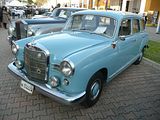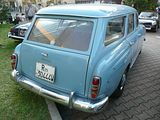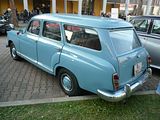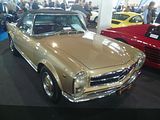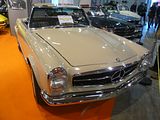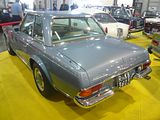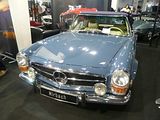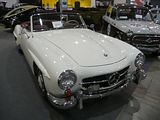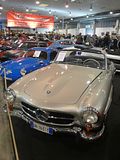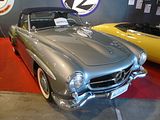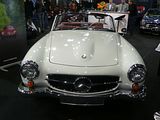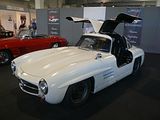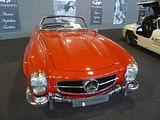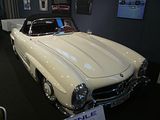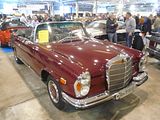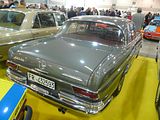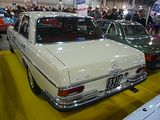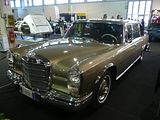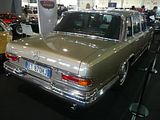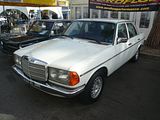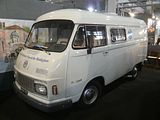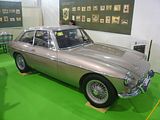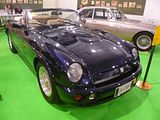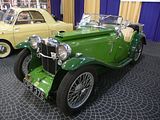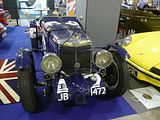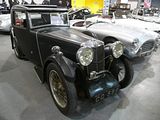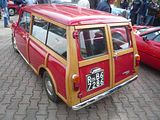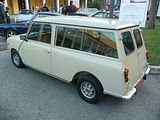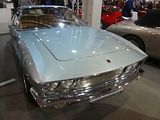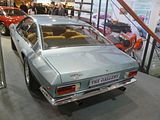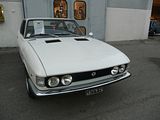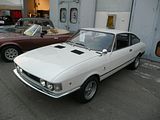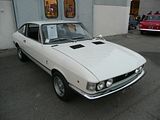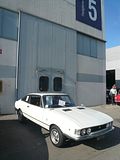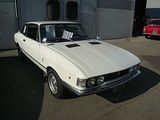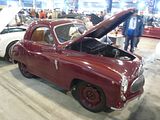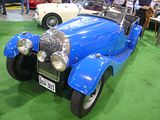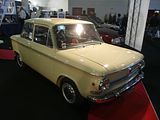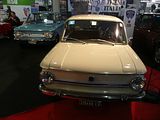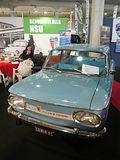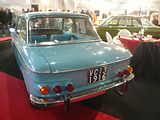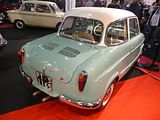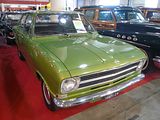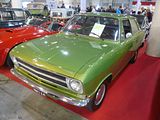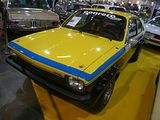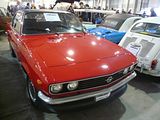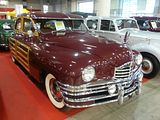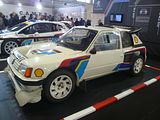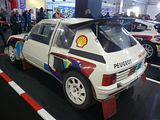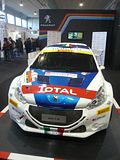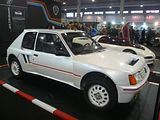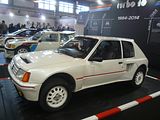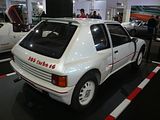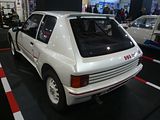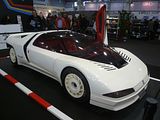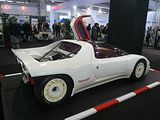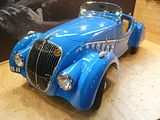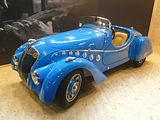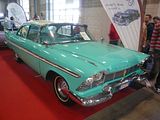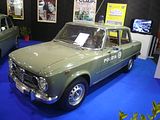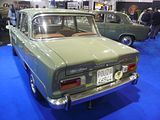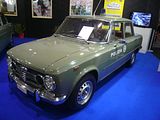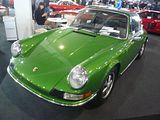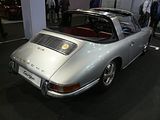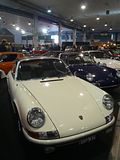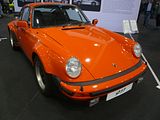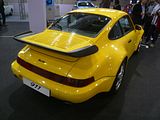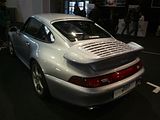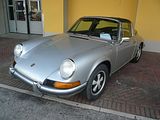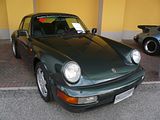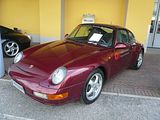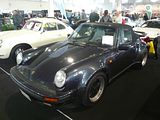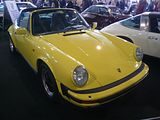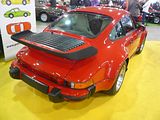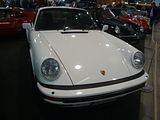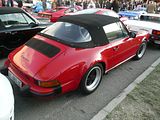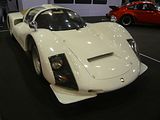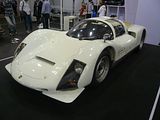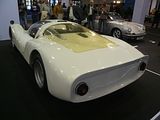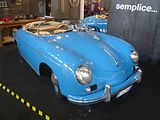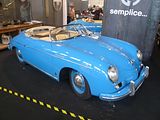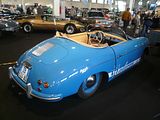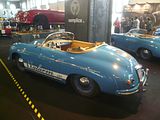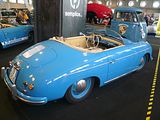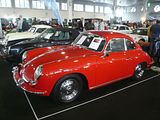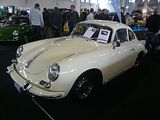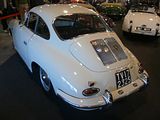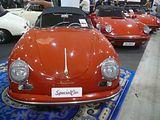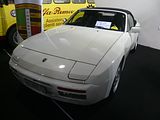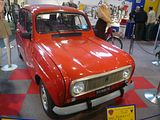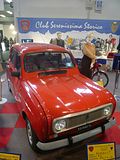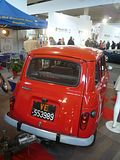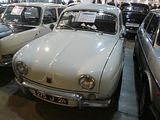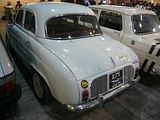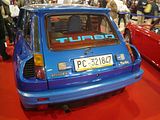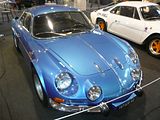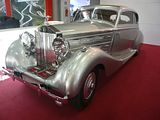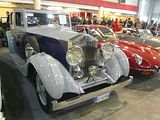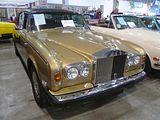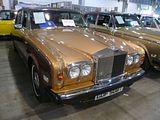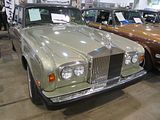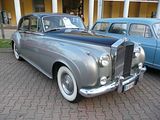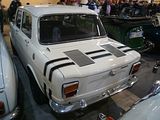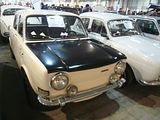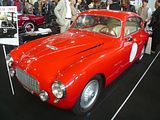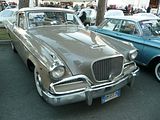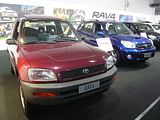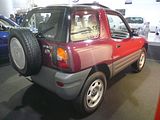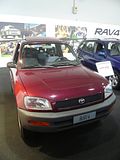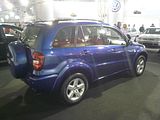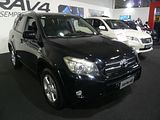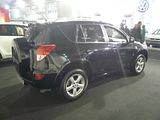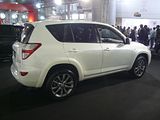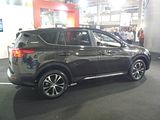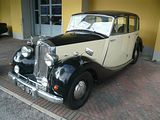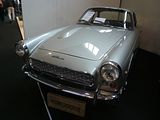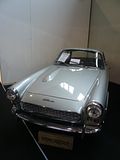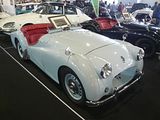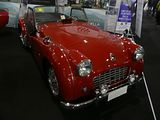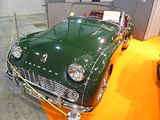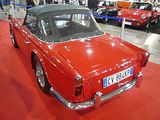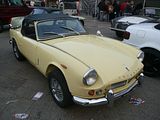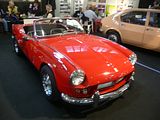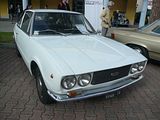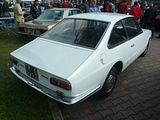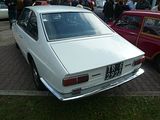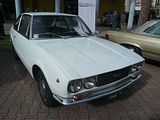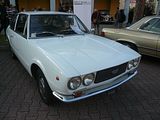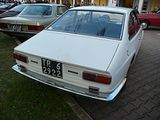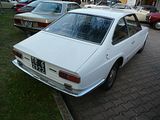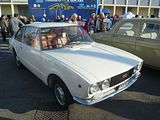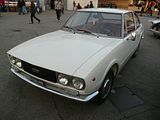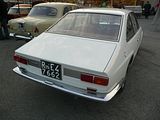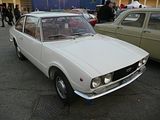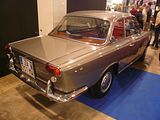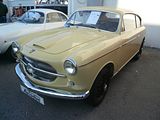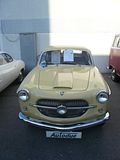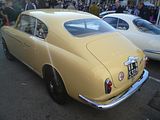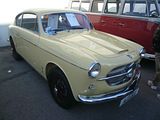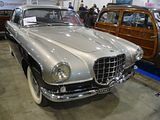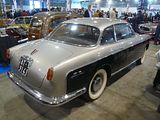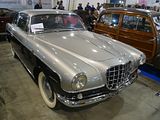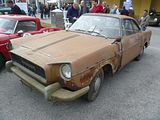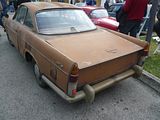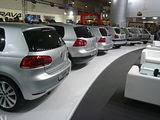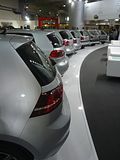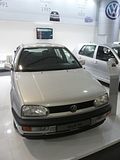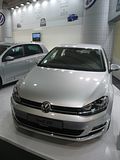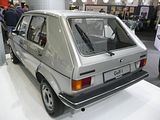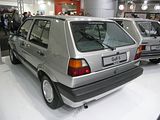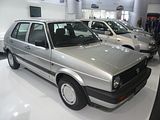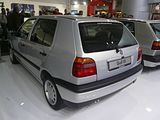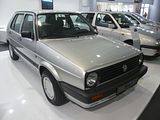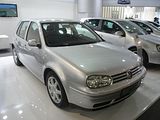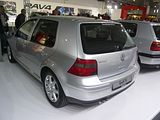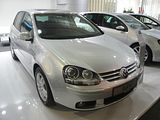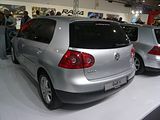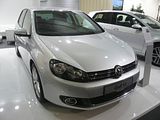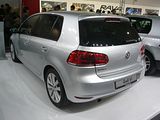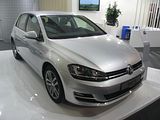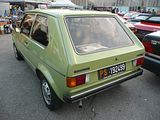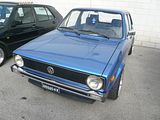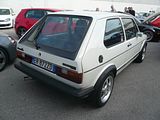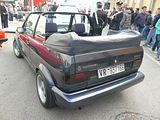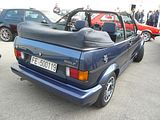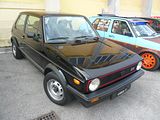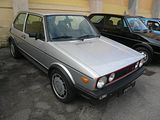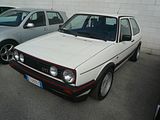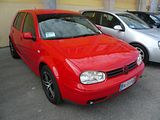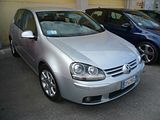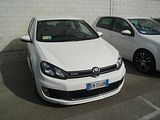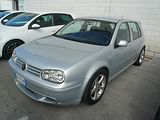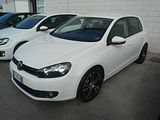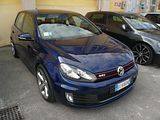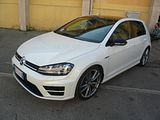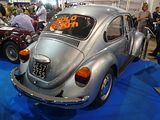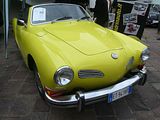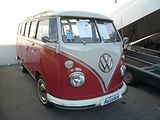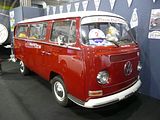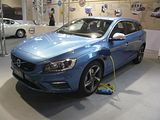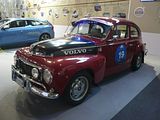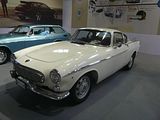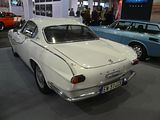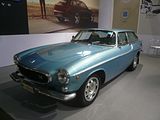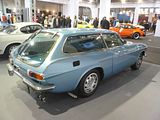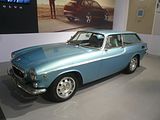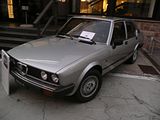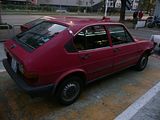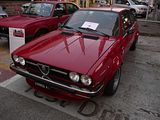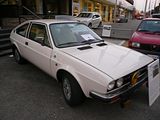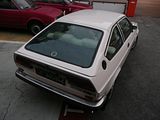Some years ago, I found out that if you go to one of the major classic car shows outside the UK, you get a very different cross-section of exhibits from those cars which tend to frequent shows held on our shores. That is not entirely surprising, I guess, as although the same cars are now generally offered in every market in Western Europe, if you go back 30 years or more, then it was a very different matter, with locally produced cars dominating their own markets. The major events across Europe are now well publicised on the internet and in the specialist press, so finding out what is on and figuring out which events might be worth attending is not difficult. As a lover of Italian cars of all ages, it goes without saying that gatherings of old cars in that country are likely to have even more appeal than almost any other to me, and the largest and most pre-eminent gathering of classic cars in that country is the Auto e Moto d’Epoca which takes place at the Fiera in Padua, a historic Italian city in the north east of the Emilia Romagna. There’s no airport in the city, but there is one in Venice, not too distant to the north east and Bologna, an hour to the south west. I went to this event in 2011 and was bowled over with the quantity of machinery on display quite apart from the rarity of much of it, with many cars that I had never even seen in pictures let alone in the metal before. I put it on the events calendar for 2012 and 2013 but for some reason, never quite managed to make the trip, but for 2014, I found a cheap flight from London to Bologna, a good deal with a hotel a few km from the airport and Mr Hertz obliged with a sensibly priced rental car to convey me around the area for the weekend. The trip nearly did not happen, as it was announced that Italy would be gripped by strikes on the day I was due to fly, but the Gods clearly wanted me to attend, as my flight was unscathed by the problems. Safely in Italy, I made an early start on the Saturday morning, and arrived in Padova (Padua) just around the time that the show was due to open. A word of warning: there is car parking but it is scattered around the city, quite a walk from the Fiera itself, and it does get very full, so you may wish to allow for this. Even so, I was in the event a few minutes after opening and then had around 9 hours to see what was on show. There are 15 halls, some of which are interconnected, and there are at least as many cars parked up outside as there are indoors, with an estimated 1600 vehicles on display in total. A mix of Car Clubs and dealers offering vehicles for sale results in an amazing and very diverse array of cars to enjoy, as you will see from this report, which present the highlights as captured by my camera in just under 900 photos.
A GOOD START
There can’t be many airports in the world where you will find Lamborghini cars in the terminal. But as I headed out of the arrivals area in Bologna towards the car rental desk, my eye was caught by a bright yellow Jalpa. On approaching it, I soon realised that there was also an Aventador parked up around the corner. I can tell you that I was far from the only arriving passenger who stopped, reached into their bag to find a camera and took a couple of snaps.
Of course that was the merest taster for the treats that were in store for me the following day when I arrived in Padua at the Fiera.
ABARTH
These three 595 and 695 models from the 1960s were on a small stand that was attracting a lot of interest.
This 850 model looked quite innocuous from a distance. Based on the Fiat 600, these models were produced in small quantity when new, though a lot more have been created in recent times.
This is what the 850 and 1000TC models more usually look like.
Abarth worked his magic on the 850 range of Fiats as well, creating the OT1000 cars. More commonly seen in Coupe guise, the Saloons were so breathed upon as well.
In 1957, Abarth produced a number of these Zagato styled 750 models. Based on the chassis of the regular Fiat 600, but clothed in a distinctive Zagato body, 43 bhp was extracted from the 747cc engine which was enough to give the cars a top speed of around 95 mph. In a constant quest for more speed, Abarth continued to modify the car, with new and more powerful variants appearing in the following years. Very petite now, they were very effective in motor sport, despite being smaller than their rivals of the day. These cars are rare now and prices are high on the rare occasions that one comes up for sale.
A more potent 1000 version was added to the range.
I was fascinated by this car, the Abarth badged Stola Monotipo. Produced in 1998, and shown at the Turin Show that year, this Abarth Monotipo was designed by retired Pininfarina designer Aldo Brovarone, a close friend of Stola managing-director Alfredo Stola. It used Lancia’s 260 bhp 2.0 16v turbocharged engine along with a limited slip-diff and huge Ferrari-sourced Brembo ventilated disc brakes. The body was made almost entirely of composite materials, all based around the Fiat Barchetta. The Monotipo drew on race car themes throughout the design, including built-in air jacks, intergrated towing eyes, Momo seats, steering wheel and gearknob as well as running on 18-in O.Z. wheels fitted with Goodyear Eagle F1 tyres. The doors swing upwards at the touch of a hidden switch, while the roof comprises of a long, sweeping aerospace-developed Plexiglass roof panel. Fiat’s close relationship with Stola allowed them to licence the “Abarth” tag, and traditional Abarth scorpion badges are located at the front and rear. It remained a one-off concept, though.
AC
Needing no introduction is the Cobra, an example of which was offered for sale.
Elsewhere, and still on British plates, was an Ace, the open topped sports car that was the inspiration for the Cobra.
ALFA ROMEO
More or less the first cars I came were a pair of classic Alfas, mounted up high on plinths, and with lighting which made life particularly difficult for the photographers. The cars on this stand were a 6C 2500 and a 2600 Spider.
There were other examples of the 6C 2500, the car that Alfa made in the 1940s when production resumed after the cessation of European hostilities. It is the sporting bodies that are most often seen, but a small number of Berlina models were made, and it was nice to see one of these at the event.
The first 6C 2500 models were made before the war. This Touring Superleggera model dates from 1939.
Perhaps not classically beautiful, but amazing to look at was this 1952 C52 Disco Volante Coupe The C52 was conceived during an unstable period for Alfa Romeo. While the company had just taken the 1951 Formula 1 World Championship, post-War cash shortages within the firm led to its withdrawal from the competition, with the 1900 Berlina road car deemed to be of higher importance. But the competition department was allowed a stay of execution, partly hinging on the promise that it could create an image-boosting race car for entrance into the 1952 Le Mans and Mille Miglia, with the potential to be sold to amateur racers. Using the 1900 as a basis for the C52 to save money, the competition department took the design of the car’s 1.9-litre four-cylinder iron-block engine and fashioned an aluminium block with an increased bore size. The 1997cc engine now developed 158bhp and was integrated into the 1900’s existing tubular frame steel chassis, with the modifications resulting in an overall weight of just 735kg. The final car was capable of an impressive top speed of around 140mph. However, it was the C52’s bodywork which made it so extraordinary. Coachbuilt by Carrozzeria Touring, the car’s curvaceous, wind-tunnel tested surfacing not only gave the C52 a super-low drag coefficient (0.25 Cd, less than that of the 2012 Tesla Model S), but also inspired the internal nickname of Disco Volante, Italian for ‘Flying Saucer’. The unofficial name subsequently caught on, undoubtedly due to the public interest in space exploration and extra-terrestrial sightings in the 1950s. Coincidentally, the name was also rather fitting in another sense – finding a comfortable seating position within the cramped cockpit required bodily proportions of a creature more other-worldly than human, partially due to the strangely offset tunnel for the four-speed transmission. But this was of no concern to the public, who embraced the Disco Volante and its revolutionary streamlined contours – though the car’s influence went far further than this, with the bodywork also said by many to have inspired the celebrated Jaguar that it’s so often initially mistaken for. Undeniably, one needs look no further than the side profile of the Disco Volante coupé to notice some striking resemblances to the E-type, regardless of the Alfa’s half-metre length deficit alluding to a more upright posture. And the Disco Volante’s impact wasn’t limited to the 1950s: the 2010 Fiera Milano saw the inauguration of a bronze sculpture of the car to mark Alfa Romeo’s centenary, while the Pininfarina 2uettottanta concept of the same year made use of some subtle Disco Volante flourishes.
Introduced at the 1950 Paris Show, the 1900 Berlina was Alfa Romeo’s first car built entirely on a production line. It was also Alfa’s first production car without a separate chassis and the first Alfa offered with left-hand drive. All models until that point had effectively been low volume cars. The chassis was designed specifically to allow coachbuilders to rebody it, the most notable of which was the Zagato designed, 1900 Super Sprint Coupe, with an improved engine and custom body design. The Alfa Romeo 1900M AR51 (or “Matta”) was a four-wheel drive off-road Jeep-type vehicle based on the 1900. Production at the company’s Milan plant continued until 1959: a total of 21,304 were built, including 17,390 of the saloons.
2014 marks the 60th anniversary of Bertone’s achingly pretty Giulietta Sprint. Believe it or not, this car was never intended for volume production. Alfa had run a lottery scheme to raise the funds necessary to allow them to develop the Giulietta Berlina, and people started to get rather anxious that there was no sign of the cars that they had helped to finance. Bertone produced this stunning design and the idea was that a handful would be given away as prizes, to calm public disquiet. Of course, when people saw the Sprint, everyone wanted one, so it had to be prepared for a far greater volume of production. A special display contained three of these cars, including a one-off Spider design from 1956 that is now owned by renowned collector Corrado Lopresto. Not surprisingly, there were several of these cars in various places around the event, along with the production Spider models.
The SS, or Sprint Speciale version was much more expensive than the regular cars, and you were largely paying for the very different and striking body style.The first prototype of the Giulietta SS was presented in 1957 at the Turin Motor Show. After two more prototypes were presented in car shows, the official presentation of the production version for the press was on 24 June 1959 on the Monza race track. The first 101 cars produced had “low nose” and 750SS designation. 100 cars minimum were needed to homologate a car in FIA regulations. All these cars had steel bodies with aluminium boot, bonnet and doors. The first cars were equipped with Weber 40 DCO3 carburettors, later changed to 40 DCOE2. There were some all-aluminium cars produced. The drag coefficient of the Sprint Speciale is 0.28, a very impressive figure for its day, and not surpassed for more than twenty years. Cars used the 1,290 cc Alfa Romeo Twin Cam engine, a design with hemispheric combustion chambers and valves controlled directly by twin overhead camshafts. The Sprint Speciale was a real race car to compete with the Porsche 356. It has a front engine with rear wheel drive. Small changes to a production version included steel doors, Weber 40 DCOE2 carburettors, higher front nose, removal of the plexiglas windows, bumpers were fitted front and rear, and the cars had some minimal sound-proofing. With the 1290 cc engine and 100 hp of power the maximum speed was around 200 km/h (124 mph). The 1.3 litre engine and gearbox was the same as used in race-oriented Giulietta Sprint Zagato. All Giuliettas SS had three-shoe drum brakes at front wheels and drum brakes at the rear. Export versions had 101.17 designation. Side badges had “Giulietta Sprint Speciale” script. The bigger engined 1.6 litre Giulia series replaced the Giulietta and was introduced in March 1963 at the Geneva Auto Ssalo. Giulia was a wordplay, claiming the new car was a grown-up version of the Giulietta. In spite of a Giulia SS prototype, Alfa Romeo decided to retain the Giulietta-shaped SS in production. The 1,570cc engine made up to 200 km/h (120 mph) possible. The 1,570cc engine with Weber 40 DCOE2 carburettors was taken from Giulia Sprint Veloce and delivered 112 hp. Most Giulias SS had disc brakes at front wheels. An easy way to distinguish the Giulia SS from the Giulietta SS is by the dashboard. The Giulia has a leather underside with the glovebox at a different angle than the main fascia. The dashboard in the Giulietta is sloping and painted in one colour without a leather underside. Side badges had “Giulia SS” script. Production ended in 1966. 1,366 Giulietta Sprint Speciale and 1,400 Giulia Sprint Speciale were produced. 25 cars were converted to right hand drive by RuddSpeed
There was a regular Berlina model in the Giulietta range as well. Despite only having a 1290cc engine, this car punched well above its weight, and is popular now among the historic racing fraternity as well as those who like their road cars in original guise.
Follow on to the 750 and 101 Series Giulietta models were the 105 series cars. First shown in 1962, the Giulia Berlina was the core of the range, which then grew when some of the old Giulietta models, such as the Sprint (Coupe) and Spider were updated to join it. During a 15 year production life, lots of different versions were offered. The basic shape did not change much, though the last cars, called Nuova Giulia, had a reshaped bonnet, two parallel headlights and impact absorbing bumpers.
The Giulia GT, which later became the popular 1750 GTV and related cars came a year later. A considerable number of these models were present, as you might expect. Included on the Giulia Register stand was one of the super desirable GTA models, in original and pristine condition.
Also part of the 105 Series were the Spider models. Starting out as the 1600 “Duetto” in 1966, this model evolved through 4 distinct generations and was produced for almost 30 years. There were plenty of these on show, with a preponderance of them being the S4 cars.
There was also an example of the Junior Zagato. First seen in public at the Turin Motor Show of 1969, the GT 1300 Junior Zagato was a limited production two seater coupe with aerodynamic bodywork penned by Ercole Spada while he was at renowned Milanese styling house Zagato Based on the floorpan, driveline and suspension of the 1300 Spider, the Junior Zagato had a floorpan shortened behind the rear wheels to fit the bodyshell. the model evoked the earlier, race-oriented Giulietta Sprint Zagatos which featured aluminium bodywork and had a very active competition history. However, the Junior Zagato featured a steel bodyshell with an aluminium bonnet and, on early cars, aluminium doorskins. The Junior Zagato was not specifically intended for racing and did not see much use in competition. In total 1,108 units were constructed, with the last being built in 1972 although the records suggest that a further 2 cars were built in 1974. In 1972 the 1600 Zagato came out of which 402 units were produced. In this case the floorpan was unaltered from the 1600 Spider, so that the normal fuel tank could be left in place. As a consequence, the 1600 Zagato is approximately 100 mm (3.9 in) longer than the 1300 model. This can be seen at the back were the sloping roofline runs further back and the backpanel is different and lower. The lower part of the rear bumper features a bulge to make room for the spare wheel. The 1600 Zagato has numerous other differences when compared to the 1300 Junior Zagato.so if you ever see two side by side, and were a real expert, you could probably tell them apart easily. The last 1600 Zagato was produced in 1973 and the cars were sold until 1975. The owner of this one did say that he is well aware that this is a “marmite” car, with some people loving the rather bold styling and others finding to just odd for their tastes. I am in the former category.
Alfa have had less success with their large cars over a long period of time now, which probably started with the 102 series 2000 cars which were launched in 1958, and which were updated into the 106 series 2600 models in 1962. Saloon, Sprint (Coupe) and Spider (Convertible) models were offered, and there were examples of the first and last of these here as well as a one-off chop top version of the Sprint.
There wasn’t a direct replacement for the 106 Series cars, as the 1750 Berlina that appeared in 1968 was noticeably smaller than the 2600. This car and the later 2000 Berlina model were well regarded in their time, and competed against the Lancia Flavia as well as BMW’s “Neue Klasse” 2000, and Rover and Triumph’s 2000.
The glamorous Montreal was named after a concept car produced for Expo67 which was held in the Canadian city of that name. It took Alfa a further three years to get the car ready for commercial sale, and this V8 Coupe was then offered for five or so years.
The AlfaSud Owners Club had a tightly packed stand in one corner of one of the halls, and contained therein along with versions that you do see from time to time was one of the very rare Estate models, the Giardinetta, that was only sold for a couple of years in 1975 and 1976. Around 6000 were made, and the Club think that fewer than 100 survive, with a surprising number of them in Holland.
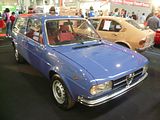
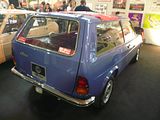

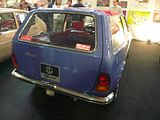
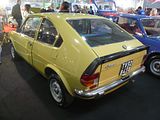
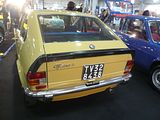
There were a few other ‘Suds in the event, with a mix of the Berlina and the ever so pretty Sprint cars.
Bigger brother to the AlfaSud was the Alfetta. Offered in Berlina and very attractive coupe GT and GTV guise, I was delighted to discover that there were several examples of both here. Whilst the GTV models are quite common in the UK, the Berlina is very rare indeed. These were early models, before the 1978 facelift introduced rectangular headlights and the adoption of rubber faced bumpers.
The Alfetta is known as the 116 Series in Alfa speak, and confusingly, so is the slightly smaller Giulietta. This striking design debuted in late 1977 and ran through to 1985. Only offered as a saloon with a choice of 1600, 1800 and 2 litre engines, this one appealed to me as a small child, and it still does now.
This is a rare Turbo version of the 75, the mid-sized saloon that Alfa launched in 1985, and which was named in honour of the 75th anniversary of the marque which was celebrated in the same year.
Elsewhere was a pristine example of the regular 1.8 version of the car and I came across a number more models outside later in the day.
If you are hoping to find a rare Italian car like the Alfa 6, then this is the place where your luck is likely to strike, and sure enough, there was one of the facelifted Alfa 6 models.
Parked alongside it was the far better known, but now surprisingly rare 164 models. I drooled more than a little at this point, as I have very fond memories of mine, and I still think is probably the most elegant saloon car design of all time.
Another really lovely Alfa (there are many, of course, so this is a relative term!) was the recent 8C model, seen here in Spider form.
Few people know that Alfa did make a small number of vans, but in fact they did for a considerable time.The first such, the T10 “Autotutto” (“all purpose”) was presented at the 1954 Turin Motor Show as a panel van or a minibus. More versions followed, with the range extending to a van, high roof van, “Promiscuo” (van with additional side windows and rear seating), minibus, school bus, ambulance, pick-up, drop-side truck and double cab truck. In addition to this many coachbuilding companies made their own versions. The van used the 1,290 cc Alfa Romeo Twin Cam straight-four engine with 35 bhp which gave it a top speed of 60 mph. This engine was later used on Giulietta Berlina. There was also a two-cylinder supercharged diesel version with 30 bhp available. Various updates kept the can competitive until 1967, when it was replaced by the Giulia engined F12 and A12 vans. The front of these vehicles was updated with wider chrome and mesh grill, and the 1,290 cc Twin Cam engine was uprated to 52 hp. The front-engined van had four-speed gearbox and front-wheel drive. In 1973 an inline-four 1,760 cc Perkins diesel was also offered, which offered 50 hp, and this same engine was also available in the Giulia sedan from 1976. The van had a top speed of around 115 km/h (71 mph). The front brakes were discs and rear ones drums. Abandoning the use of a model name, “F” depicted a furgone, or van, “A” depicted an autocarro or light truck, while “12” indicated the carrying capacity of 12 quintale (1 quintale = 100 kg (220 lb)). Between 1967 and 1971 a “light” A11 or F11 version was also available. This has a lighter payload and a lower horsepower rating. All Alfa Romeo vans were facelifted in 1977 with a new black plastic radiator grill, and chrome badging was replaced with black adhesive stickers. Production stopped in 1983. The total production of all A11, A12, F11, and F12 was around 17,300 units.
Also little known is that Alfa assembled a number of the Renault Dauphine in Milan under licence between 1959 and 1964. Distinguished by the Alfa badging, the cars had different lights and a 12 volt battery.
I’ve saved the “best” Alfa til last, though. These were the cars shown on the factory stand, and which are part of Alfa’s own collection. Enjoy a 1931 8C 2300 “Le Mans”, and a 1924 P2 as well as the Targa Florio winning RL model from 1924.
There were also a couple of Giuliettas, the first and the current one.
AMPHICAR
The Amphicar Model 770 is an amphibious automobile, the first such vehicle mass-produced for sale to the public, starting in 1961. The German vehicle was designed by Hans Trippel and manufactured by the Quandt Group at Lübeck and at Berlin-Borsigwalde, and used Triumph Herald components under its glassfibre body. The name is a portmanteau of “amphibious” and “car”, and it truly could be drive on the road, and then by pulling a lever, converted into a boat. Compared to most boats or cars, its performance was modest, and it was expensive, so it is no surprised that only 4000 were produced by 1965. Most of them were sold in the USA, and most of them have rusted away as once they got wet, well, you can imagine what that did to the metalwork. Nevertheless, it is still among the most successful amphibious civilian autos of all time, and still often prized and preserved as a novelty collectible automobile. This one was in splendid condition.
ASA
By the late 1950s, Ferrari was in need of the money that would be generated by far a greater volume of sales, but he was nervous about extending downmarket, so when he decided to launch a much smaller and cheaper model, he decided it would not bear the Ferrari name. Instead, he went to ASA, and although the design of the resulting car was his, the 1000 GT did not bear Ferrari badges. The car was developed by Giotto Bizzarrini from Ferrari’s design, and manufactured by the ASA company in Milan (in a factory owned by the De Nora Electrochemical Group) from 1964 to 1969. The 1000 GT model was presented in 1962, but production started two years later. Bodywork was designed by Giorgetto Giugiaro at Bertone. This small GT car featured an OHC 1,032 cc four-cylinder engine designed by Ferrari engineers, for a Ferrari project, originally dubbed “Ferrarina.” The original engine design was basically a four-cylinder, 850 cc slice of a Colombo V12 from a Ferrari 212, complete with characteristic “clothes pin” valve springs, and breathing through two Weber 40 DCOE9 carburettors. The 1000 GT featured a double wishbone arrangement for its front suspension, with a live axle at the rear. Both ends of the car featured coils springs, tubular dampers, and an anti-roll bar, as well as disk brakes. The coupe model was bodied in steel, with aluminium for the bonnet and boot lids.
ASTON MARTIN
Cars on the Aston Martin Club stand included a DB4 and the very latest Vanquish Volante
When the long-lived Williams Towns designed car that formed the core part of Aston’s range for over 20 years was first shown in 1967, it came with the familiar 6 cylinder engine, as the new V8 was not then ready. It was called DBS, and was identified by twin headlights.
I only came across a couple of other Astons in the show, a DB2/4 Convertible and a DB5
AUDI
A large Audi stand focused on the marque’s most popular classic, the legendary Quattro, with an example recalling the crowning 30 years ago, in 1984, of Stig Blomqvist as World Rally Champion. Some of the earlier and notable victories that the car that transformed rallying achieved were also recorded on the posters around the stand which as well as the regular rally car contained road going versions of the Sport Quattro and the standard road car.
As there are Audi rings on this, I guess it belongs here. This is Ital Design’s Aztec concept car dating from 1988. It was offered for sale, with an extremely ambitious €750,000 price tag. I understand it did not sell.
AUSTIN
Whilst you would expect to come across plenty of Austin Seven models at an event like this in the UK, you’d perhaps not bet on seeing them in Italy, but there was one here.
AUSTIN HEALEY
A couple of late model examples of the “Big Healey” 3000
AUTOBIANCHI
The Autobianchi brand was first used in 1957, offering distinctively styled cars based on standard Fiat mechanicals. During the 1960s, Fiat used it to test ideas out on the market before committing them to the much larger commercial proposition that was Fiat, with the 1964 Primula pre-dating the front wheel drive 128 saloon by 5 years, and the A112 small hatchback the 127 by a couple. There were only a small number of different models produced during the marque’s lifetime and an example of each was gathered on the Autobianchi Owners Club stand. Bianchina, Stellina, Primula (seen in Coupe form), A112 and the larger (and rare) A111.
Three more examples of the little Bianchina featured on a stand dedicated to this model.
The Bianchina was also seen elsewhere in the show, in regular, Panoramica (estate) and Transformabile (convertible) guises.
I have a very soft spot for the A112 model, which is a cheeky little supermini, offered from 1969 until 1986. The most potent models bore Abarth badging.
BENTLEY
The first production models after the war were the Mark VI. Although many were sent off to the coachbuilders, for the first time in the marque’s history, there was a standard factory bodyshell available, of which this is an example.
BIZZARRINI
Better known for the large A3C model which had a close relationship with the Iso Grifo, there was a second car that bore the Bizzarrini name, and it was this, the Europa. “Produced” between 1966 and 1969, the original design was powered by a 1481 cc Fiat straight-4 engine, the car officially became the Europa with the introduction of an 1897 cc Opel powerplant. About 20 examples were built, with all but five using the Opel engine.
BMW
Centrepiece of the BMW Owners Club stand was an example of the Z8, the short-lived grand tourer that was made early this century in a nod to the earlier 507.
To one side was a 2002 Tii, the much loved fast version of BMW’s then entry level car and its modern recreation, the much praised M235i Coupe.
The BMW Youngtimer Italia Club stand featured a couple of open topped 3 series models, an E30 and an E36 and the now rare E23 7 series.
Following the success of BMW’s venture with Isetta, selling the small bubble car, which kept the Bavarian marque afloat in the 1950s, BMW decided to produce a small car of their own design. The result was the 600, a four wheeled car which showed clear reference to the Isetta 250 and 300 models, but with more space in it and more conventional road manners, quite apart from the fact that it had four conventional doors, making it far easier to get in and out. There was an example of the smaller Isetta as well.
The 700 came next, and this was more of a “proper” car. Offered in Saloon and Coupe guises, the success of this model allowed BMW to invest in the 1500 of the 1960s which laid the foundation for all that followed.
BMW launched a new saloon which mixed luxury with a sporting air in 1968. The E3 cars, which initially came in 2500 and 2800 guises, but to which a 3 litre with fuel injection and a long wheelbase 3.3 Li version was added during the model’s production life. Not many seem to have survived, which is a pity as this is an elegant and rather desirable car.
Sharing the same styling cues was the E9 Coupe model, which ran concurrently with the E3. This is the car which gave us the legendary CSL nomenclature when BMW produced a carefully lightened version intended to do battle on the track.
BUGATTI
Type 13 Brescia
EB110
BUICK
Very splendid was this 1949 Roadmaster Wagon.
CADILLAC
Very imposing was this 1954 Cadillac 62
Five years later, and the styling of the 59 Cadillacs had become far more bold, with the apogee of the tail fins being reached.
CHEVROLET
The Corvair was launched in 1960, and was quite a radical departure for Chevrolet, with its air cooled rear mounted engine. Intended to stem the rising number of sales of imported cars, it was far larger than them all, which gave it plenty of appeal, until it was savaged by consumer lobbyist Ralph Nader, who vilifed the car’s rather dramatic oversteering handling characteristics in his book “Unsafe at Speed”.
CISITALIA
Cisitalia was an Italian sports and racing car brand. The name “Cisitalia” derives from “Compagnia Industriale Sportiva Italia”, a business conglomerate founded in Turin in 1946 and controlled by the wealthy industrialist and sportsman Piero Dusio. Best known product from the marque is doubtless the Cisitalia 202 GT of 1946, which is often described as being a “rolling sculpture”. It was not the only product, though. Carlo Abarth joined Cisitalia after the war and applied his talents to the design of machines that could win on the track. The result was the A 1947 Cisitalia Abarth C204, and the first car ever to bear the legendary Scorpion badge. Tazio Nuvolari won his last ever race in this car, and it raced an won at the Targa Florio, Mille Miglia and Palermo-Morite-Pollegrino.
CITROEN
The futuristic CX made its debut in September 1974, 40 years ago, and the Citroen Owners Club stand was marking this with the display of one of these elegant cars.
Hard to believe, but this 2CV Charleston was manufactured some years after that CX. The design dates back to the 1930s, of course, but these cars were still being made in the 1980s.
The Mehari was based on the 2CV underpinnings. Sold for 10 years from 1968, this is a combination of cool and chic. Very nice!
Even more desirable are the wonderful DS models. The Owners Club had a number of different models on show, including the very lovely Safari.
The equally lovely SM was also on show, with a couple of examples of this technical tour de force.
Among the cars for sale were a number of the Traction Avant cars
Very different, and actually far rarer was this Visa Chrono. This was a twin carb 1.4 litre limited production version of the Visa which preceded the series production GTi cars
Another rare Citroen was this early Ami 6 Break. Later I found one of the saloon models as well.
DE TOMASO
Although better known for the Mangusta and Pantera cars, De Tomaso also produced a luxury saloon which looked not unlike a Jaguar XJ6, the Deauville. First exhibited at Turin Motor Show 1970, the car was powered by the same 330 bhp 5763 cc Ford Cleveland V8 as the De Tomaso Pantera, which gave it a top speed of 143 mph. The Deauville had an independent rear suspension very similar to that used by Jaguar, and ventilated discs in all four wheels.. It shares its chassis with the later Maserati Quattroporte III A total of 244 Deauvilles were produced. As well as the saloons, one Deauville station wagon was made for Mr. De Tomaso’s wife and two armoured Deauvilles were made, one for the Belgian Royal Family and one for the Italian government. One of these cars is displayed in the Museo delle Auto della Polizia Di Stato in Rome,the other was owned by an American and participated in the 1997 Concorso Italiano. Production ended in 1985.
DELAHAYE
The last Delahaye models, built after the second world war, were the 235 cars, which were offered with a wide variety of coachbuilt bodies.
DODGE
1951 Coronet Gyro-matic Convertible
FERRARI
A very special display of one-off and prototype Ferrari models, provided by the factory from nearby Maranello were presented in an area linking a couple of halls together, and needless to say, were drawing the crowds, as this would be the first time that many had seen any of the exhibits.
Scoop photographers got very excited by this one in the day. what was known as the F150 Prototype. When the disguise came off, we got the LaFerrari, of course.
Although you might think that this is just a 360 Spider, a closer look will reveal that it is not. In fact, it is a one-off 360 Barchetta which was built for the Chairman’s wedding in 1999.
The bumps on the bonnet of this 612 Scaglietti give away the fact that it is not a standard road car. It was used as a suspension test rig for the latest adaptive dampers and front gearbox for the four-wheel drive mechanism on the FF. The improvised bonnet adaptations were required for relocated airboxes for the V12.
Looking like a slightly oddly proportioned 348, this is one of three engine test mules, first used in the mid-90s and in this instance mounted with a 430’s V8. The sizeable gap between the front of the engine block and the bulkhead allowed for the installation of V12s, V8s and, apparently, an experimental V10 at one stage too. The extra 130mm in the 348’s wheelbase was required by the shift from the transverse to longitudinal gearbox used on the later 360. This mule outlived the car whose drivetrain they helped develop and endured into the Enzo era.
This is an F430 prototype.
This was a concept based on the 599, but adopting the HY-KERS energy recovery system from Formula 1 into the car.
There were plenty of other classic Ferrari models to be seen throughout the show, none of which really need any introduction, as these are production cars that although in some cases are rare, are at least well known.
The 250GT was the result of a desire to enter series production in order to stabilize the company’s finances, Enzo Ferrari asked Pininfarina to design a simple and classic car. After constructing the 250 GT Boano/Ellena, Pininfarina’s Grugliasco plant was expanded and the production of a new coupe could be moved back. The resulting car was introduced at Milan in 1958, and 335 nearly identical examples were built by 1960. Buyers included Prince Bertil of Sweden. The GT Coupe eschewed the fender vents for simple and clean lines and a notchback look with a panoramic rear window. The oval grille was replaced by a more traditional long narrow look with protruding headlights. Telescopic shock absorbers were also fitted instead of the Houdailles found on previous 250s, and disc brakes were added in 1960.
330GT
Intended to take the place of the 275 GTB, was the car which started off as the 330GTC A two-seater coupé with a Pininfarina-designed body, the 330 GTC was introduced at the Geneva Show in March 1966, and the open topped 330 GTS followed at the Paris Show later in the year. Both 330 GTC and open topped 330 GTS shared the short wheelbase of the 275 as well as its independent rear suspension. These models were more refined than earlier Ferraris, quieter and easier to drive. It has been stated that this “was probably the first Ferrari in which you could actually enjoy a radio”..A 1967 GTC was given one-off bodywork by Zagato at the behest of American importer Luigi Chinetti in 1974. This car was called the “Zagato Convertibile”, since it was of a targa-style. About 600 coupés and 100 spiders were produced before the 1968 introduction of the 365 GTC and GTS 2 seater. The 365 models are visually very similar, and a couple of examples of them were on display here
Two of the loveliest Ferrari models of all time in my opinion are the 246 GT Dino and the 365 GTB/4 Daytona, and there were examples of both of them on show.
V8 cars from the 1970s were represented by a 308 GT4 Dino, a 308 GTB and GTS
Nice to see a couple of the legendary Berlinetta Boxer cars, object of almost every school boy’s dream in the 1970s. Both were the later 512 BB here.
As well as the 1980s Testarossa – object of desire for many a small boy when it was new – there was a rare F512M, the last iteration of the model, with the pop-up headlights replaced by these less than subtle glass topped units.
F355 Berlinetta
Not quite sure what to make of this. Starting point was a 1989 412i which Italian coachbuilder Pavesi transformed into something that is certainly different, called the Ventorosso This was not the first or only car that Pavesi modified. Subjects for other soft-top experiments by the firm include a Testarossa, although it is less well known than other conversions such as Straman’s. Pavesi also did work on De Tomasos and Maseratis, as well as armour-plating government vehicles. The stock factory-sanctioned Pavesi conversions – carried out on nearly 20 400is – were fiercely expensive in their day with figures of up to €80,000 being bandied around so I am sure that a fully reshelled car with electric retractable roof like this will have been very costly when new. The first car was based on a write-off, the frame was reinforced, the bonnet and boot made of aluminium and the bumpers glassfibre, but the rest remained steel. The job took two and a half years from when Pavesi bought the 1989 412 (April 1991) to completion in September 1993. It is claimed that three of these were made, though no-one has been able to substantiate this. This one has been in an Italian telecomms museum for a long time, but surfaced earlier in the year when it was auctioned by Coy’s in Monaco. Someone clearly liked it enough to shell out €61,240 for it.
FIAT
There were some really splendid, and rare, pre war Fiats on the Registro Fiat Italiano stand, some better known than others. A couple of them were based on the 508, mainstay of the range in the early 1930s. The pretty little Balila Sport is quite well known, and examples are seen at classic shows and indeed action events quite frequently. There was also an open topped 508 model.
Also on the stand was the imposing 525N, a car which some will know as it featured in French diecast model maker Solido’s “L’Age d’Or” range of models for many years.
A couple of regular 508 Balila Berlina models were to be found on other stands.
There was an even older Fiat at the event, with this 1910 model featuring on a stand with a number of other Edwardian era cars. This is a Fiat Tipo 5 of 1910, which had an engine size of 9017 cc, which generated 75 hp. The body was made by the French firm Rothschild.
No surprise to find lots and lots of different 500 models here. First launched in 1936, the original Topolino was the car which really put Italy on wheels, and the first models have the characteristic sloping front that makes them instantly recognisable. rarity among the display cars was this Giardinetta version, which proudly proclaimed itself as the only one in the show.
Revised 500b and 500C models followed post war, and as well as the saloon models, there was an estate model called the Belvedere. Several of these were on show, and there was a nice display of some commercial derivatives as well.
1957 saw the launch of the much loved Nuova 500, a cheeky little car that is loved the world over. A lot were produced, and thankfully a lot have survived, so it is no surprise that there were plenty of them on show here, including some of the more versatile Giardiniera estate model. Thee was even one of the open air Jolly cars.
The 600 was a massive hit when it was launched in 1955, offering more space than in the 500. It had a relatively short production life in Italy compared to other countries who produced it, with SEAT making their version until well into the 1970s, and Zastava theirs until the late 1980s.
My favourite Fiat models of all time are, without question, the glamorous Dino cars that were produced from 1967 to 1973. Offered as Coupe and Spider, with very different styling, these elegant cars initially had a 2 litre Ferrari engine, which was later enlarged to 2.4 litres, though purists will tell you that the earlier one is the one to have. Interest in these models, especially the stunning Spider, has really taken off in recent years and prices have climbed from the low levels that were sought less than 10 years ago. Several of the cars here were for sale, but exporting a car out of Italy is something that requires specialist help, so an impulse buy, although tempting, remained just a dream for me.
Three years after presenting the 128 Saloon, which had a high revving 1.1 litre engine to power it, Fiat followed up with a more powerful version, called the Rally. Here’s one of the few survivors. Later I found one of the facelifted saloon models produced between 1976 and 1978.
There was a Coupe version of the 128, but this only ran for 3 years before being replaced by a three door Hatch model, the 3P. There was one of these on show.
Preceding the 128 by some years were the 1300 and 1500 family cars, that Fiat offered from 1961 until 1966.
Positioned below it in the range was the 1100. Tracing an ancestry all the way back to the 1930s, the style for the Millecento was set in the early 1950s, with a number of revisions made right up until the model was deleted in the late 1960s. As well as a late 1950s example there was a later car, dating from around 1963, by which time the suicide style front doors had had their hinges moved to the front of the door, and the level of equipment had been improved as well as a slightly larger and more powerful engine under the bonnet, creating the 1200 Grand Luxe model, and late in the day I came across a Pickup version and another 1100.
For the final years of production, the engine went back to 1100cc and the styling was tidied up again, creating the 1100R. This car was offered in Estate guise as well as Saloon, and here is an example of the former.
Fiat launched a new series of large cars in 1959, the 1800 and 2100. Styled by Pininfarina, they bore a striking resemblance to the Peugeot 404 that followed a few months later and the BMC Quintet of Austin Cambridge, Morris Oxford, Riley 4/68, Wolseley 15/60 and MG Magnette. To my mind the Fiat was the neatest of the designs. The cars were sold in the UK when new, but were expensive, so few made it and these days just a couple of the cars are believed to be on UK shores. This is an early 1800 Berlina.
The 1800/2100 range was facelifted in 1962, with the top spec model receiving a larger engine and new name, 2300. Fiat then added a stylish Coupe to the portfolio, the 2300S Coupe. This was an expensive car when new.
It was some years after the 2300 range was deleted before Fiat produced another large car. The result was the 130, which, although premiered in 1969 was slot to each production. Berlina and Coupe models were produced, and as far as I could tell, this Coupe was the only representative here.
The 850 was launched in 1964. A small rear engined car, it was intended to take the place of the 600, offering more space, performance and luxury (it’s a relative term!). The original saloon model was joined by very pretty Coupe and Spider models. A couple of the Coupe cars were among the many cars offered for sale. Very tempting!
The Familiare version was billed as the Estate model in the 850 range, but in reality it was more like a small van with windows. It had lots of space in it, but if you loaded it up, fast it was not, even when the later 903 cc engine was fitted.
The Fiat factory never made a 4 door model (unlike SEAT), but one of the coachbuilders stepped in, and this was the result, the Lombardi Fiat 850 Lucciola.
A real oddity was this, based on the first Multipla, but converted to include a small crane on the rear deck.
The 124 is a familiar design to many people, thanks to the fact that it was adapted for use by Russian marque Lada, as well as being built in Spain by SEAT. But original Fiat 124s are very rare now, so it was nice to see this one, a late model car as evidenced by the grille design.
The 124 Sport Register had a couple of cars on their stand. One was a familiar AS model with the chrome bumpers which really gave the car quite a pert appearance. Alongside it was something very special, a one-off restyle, remodelled to look like the Pininfarina Rondine which had inspired the 124 in period. Both were designed by Tom Tjaarda.
Elsewhere was another one, in racing trim, another AS car and a couple of later model CS cars, with the big impact absorbing bumpers which were mandated by the US market, which kept the car in production for so long.
The splendid X1/9 was not ignored, with these examples on display.
Over 5 million 127 models were sold in the 1970s and early 1980s, but very few are left thanks to the poor quality steel out of which they were made. It was nice to see this one, the lone example at the event, a 127 Sport from the late 1970s.
The mid-sized 131 Mirafiori was also a big seller in its day, with Saloon and Estate models on offer. In 2 door form, it achieved notable success as a rally car, too, as this one reminds us.
This splendid 238 Van was Fiat’s competitor to the better known VW Type 2. This is a late model version, with the black painted bumpers and grille being the distinguishing points.
Outside I came across another 238, this time a drop side pick up.
The Tipo 138, as it was codenamed, and the Ritmo (or Strada in the UK and US) was a dramatically different looking car when it appeared in 1978, the first all new Fiat for a number of years. “Handbuilt by robots”, the adverts told us, this was one of the first cars to be assembled not by truculent manual workers, so you might have hoped that build quality would have been exemplary. Sadly, the steel from the which bodies were made was very poor, and so the cars rusted just as quickly as their antecedents, and few Ritmo models remain. Most of those that do are the sporting ones, like this 105TC, the top of the range for a while until the hotter Abarth 125TC and 130 TC models came along.
I don’t believe that this Police version of the Stilo was actually intended to be a display car, although it was parked up among other cars which clearly were, as these cars are still in active service with the Polizia. In years to come, though, especially given the relative rarity of the commercially unsuccessful Stilo 5 door hatch, this could well be a rarity that will occasion comment when people see one.
Many Italian coachbuilders produced their own versions of Fiat models in the 1950s and 1960s, for those who wanted something that bit different and who were prepared to pay the extra costs. Relatively few of what now amounts to a long list of different cars were produced, so these are rare and information about them is scarce. This one is based on the 1100 of the early 1950s.
Dating from 1949 was this very unusual looking machine, the Padovan Aerodynamica 1100TV. It is based on a Fiat 1500 and is believed to have been inspired by a combination of the Czech T77 & T87 Tatras and the Porsche 356. The streamlined bodywork was hand made in aluminium by the talented Mr. R. Padovan in Pordenone (Northern Italy) in 1949, who was a craftsman, not a professional coach builder. His sons have been known to report that the car was built from 1947 to 1949. The heart of the vehicle is a four-cylinder overhead valve engine with a capacity of 1089 cc. which develops 50 hp at 5400 rpm. It is able to propel the car to 143 km/h. It has a small cabin with enough room for the driver and passenger. It would appear that it was shown at TechnoClassics in 2012, and was presented here, for sale, with an asking price of around €225,000.
FORD
There were surprisingly few Fords present at the event. First ones to catch my eye and my camera were both American, a Model A and an early 1940s De Luxe V8 model.
Later I did find this rather nicely presented Sierra XR4i.
Back on the American Ford theme was this first generation Thunderbird.
GHIA
GOGGOMOBIL
Goggomobil was a series of microcars produced in the Bavarian town of Dingolfing after World War II by Glas. There were three models on the Goggomobil platform: the Goggomobil T sedan, the Goggomobil TS coupé, and the Goggomobil TL van. The engine was an air-cooled, two-stroke, two-cylinder unit originally displacing 250 cc, but later it was available in increased sizes of 300 cc and 400 cc. It had an electric pre-selective transmission built by Getrag and a manual clutch. The engine was behind the rear wheels. Suspension was independent all round using coil springs with swing axles. 214,313 sedans, 66,511 coupés, and 3,667 Transporter vans and pickups were built from 1955 to 1969. This is an example of the TS300 Coupe.
HEINKEL
I don’t think I’ve ever seen a van conversion of the Heinkel Bubble Car like this one. Amazing.
HORCH
1937 853 Sports Coupe
INNOCENTI
Italian marque Innocenti produced a small number of rebodied Austin-Healey Sprites in the early 1960s. Offered in Coupe and Convertible guises, these are very pretty little cars.
Innocenti also assembled their own version of the classic Mini. There are minor visual differences between these cars and the UK made ones.
ISO
Originally founded in Genoa in 1939, but transferred to Bresso in 1942 by Renzo Rivolta, an engineer and the heir of industrialists, the Iso Rivolta company was initially named ‘Isothermos” and manufactured refrigeration units before World War II. After the Second World War, the company reopened its doors, completely changing its activity. In 1948 it began to build motorcycles, scooters and motocarries (three-wheeled transport scooters/motorcycles). Among the most famous are the Furetto (1948), ‘Isoscooter (1950),’ Isocarro (1951), ‘Isomoto (1954) and’ Isosport (1953). Accordingly, the business was refounded as Iso Autoveicoli S.p.A. in 1953 to reflect the production of motorized transport. In the mid-1950s, Rivolta started to develop a miniature car for two persons and front entrance, initially with only three wheels, later, for reasons of stability, with four wheels (the two on the rear very close together): the Isetta Bubble Car. About 20,000 of the bubble cars were built at the Rivolta works near Milan. Starting in 1954, Isetta was licensed to automobile manufacturers in several countries: France (by VELAM), Spain, Great Britain and Brazil (by Romi). The most successful, however, was the German Isetta built by BMW. The BMW-Isetta went on to dwarf the production volumes of Rivolta and fulfilled the dream of mobility in post-war Germany. About 130,000 had been sold by 1962. That success encouraged Rivolta to become more ambitious, and together with engineer Giotto Bizzarrini, designer Giorgetto Giugiaro and chassis builder Bertone, Renzo Rivolta began developing the Iso Rivolta IR 300, which was first presented at the Torino Show of 1962. It was an elegant 2 + 2 Coupé with well-balanced technical components and outstanding driving performance. It had a 5.4 litre V8 Chevrolet Small-Block engine, the transmission came from General Motors in Detroit, and the de Dion suspension and four-wheel disc braking system came from the large Jaguars of the time. This concept was maintained for almost all production cars of Iso. The cars sold steadily. but in small numbers. A couple of them were on display here.
Iso Rivolta’s most well-known Gran Turismo automobile was the Iso Grifo which featured a low-slung, sporty berlinetta body by Bertone. After Bizzarrini left the project, this prototype formed the basis for his own Bizzarini 5300 GT. The Grifo Prototype was further refined by Iso, receiving a reworked, less aggressive and more luxurious body in the process, and went into production in 1965. The Grifo was powered by Chevrolet´s 5.4 litre V-8 producing either 300 or 350 hp. In 1966 a convertible version of the Grifo was shown, but never reached production. Starting in 1968 the Grifo was also available with Chevrolet’s 7 litre big-block V-8; this version was easily recognized by the broad air inlet on the hood. Later-day Grifos, the Series II, featured concealed headlights and a slightly modified front area. Meanwhile, Renzo Rivolta had died in 1966, and his son, Piero, had taken over as managing director. Under Piero’s leadership, Iso built the limousine Fidia, “the fastest four seats on wheels” (Advertisement, 1967) with body by Ghia, the Grifo 7 litre (with the GM V8 7 litre marine engine) and the 2 + 2 fastback Coupé Lele (1969) with body designed by Bertone, intended as the successor to the IR 300. At the start of 1973 the Rivolta family ceded the business to an Italian American financier named Ivo Pera who promised to bring American management know-how to the firm. The business was again renamed to Iso Motors, just before fading rapidly into obscurity, going bankrupt in 1974, only 1700 Iso Gran Turismos had been built in those ten years. That meant that the Lele was the last new design offered. Styled by Bertone, there was little wrong with the looks of the car, but build quality was patchy and the large V8 engine was thirsty so when the fuel crisis of 1974 made such cars a liability, sales reduced to next to none, and this proved the deathknell for the marque.
ISOTTA FRASCHINI
Maker of some of the most exclusive and expensive cars in the 1920s, as well as the production of aircraft engines, Isotta Fraschini is little known these days. This is an 1928 Isotta Fraschini 8A. An elegant and luxurious car, it had an inline eight cylinder 7300 cc engine. Output was declared to be “sufficient”. It had a three speed gearbox and hydraulic drum brakes. The company sold just the chassis and engine, as was the custom among the luxury cars of that era. The body of this car was built by Cesare Sala of Milan, and just this one was made.
JAGUAR
When new the Mark X was thought of as a large car, and even by the standards of today’s much bigger, and especially wider machines, it still looks sizeable.
Smaller stablemate in the range was the much loved Mark 2, offered in 2.3, 3.4 and 3.8 litre formats.
The Series 3 version of the long running XJ6 does, of course, have an Italian connection, as Pininfarina was responsible for some of the styling changes that were made. By the time this car was launched, the trend for vinyl roofs had more or less passed, but this car sports one. It does not enhance it, in my opinion.
There were not many E Types. but I did come across this nice Series 3 Roadster.
JENSEN
Quite a surprise to find this, the Jensen 541 from the late 1950s.
LAMBORGHINI
Many say that the Miura was the original supercar. Whether it is or not, it is still to my eyes, a stunning piece of design that grabs attention whenever it appears. Who cares whether it is really any good to drive when it looks like this? 338 cars were produced between 1966 and 1970. Of these, 275 were the initial P400 model which put out 350 bhp, whilst later P400S model generated 370 bhp, far fewer of which were made. There were several of these legendary cars at the event.
Replacement for the Miura was the Countach. First shown as a concept in 1971, the production cars appeared in 1973, and the model was then offered through to 1990, undergoing a number of evolutions with larger and more powerful engines as well as bodywork changes.
Following the Countach was the Diablo. Built from 1990 to 2001, this was a true Lamborghini – way over the top, with its styling and mechanicals, and sadly, not quite as good to drive as you would hope (allegedly!).
In its turn, the Murcielago came along in 2001, and it stayed in production for 10 years. This is an SV version.
The Espada was a 4 seater model, still featuring the V12 engine, made from 1968 to 1978. with over 1200 of them being produced. Long eschewed by the cognoscenti, these fearsomely complicated cars are now gaining in popularity.
Displayed near the Espada was an example of Lamborghini’s first road car, the 350GT.
The Urraco was a V8 engined car intended to take on the successful smaller engined Ferraris. Launch timing was not ideal, as it was shown just as the 1973/74 oil crisis bit, but even so, 795 were made before the car was altered in 1977 to become the Silhouette. There was not one of those on show, but there was an example of the car which took over from it, the Jalpa. Launched in 1982, this model had a larger 3.5 litre V8 engine and further revisions to the styling. 410 cars were sold, making it the most successful V8 Lamborghini there has been.
LANCIA
Oldest Lancias on show were a couple of examples of the innovative Lambda cars.
Dating from the early 1930s was this Augusta Berlina.
Although badged Lancia, the common link for these models was bodywork styled by renowned Italian Design House, Zagato. Better known of the cars shown was a Beta Spider, the open topped version of Lancia’s well known mainstay from the 1970s. It was joined by a recreation of the Aprilia Sport. The original car was designed in 1937 and competed in the Targa Florio and the Mille Miglia, but sadly was destroyed during the war.
There was an example of the regular Aprilia as well.
The Aurelia first appeared in 1950 as an elegant and costly saloon model. An elegant Coupe was added to the range soon after, and this is the car which is generally believed to be the first to adopt the much used and abused GT moniker.
Smaller brother to the Aurelia was the Appia, a V4 engined model which came in Berlina, Coupe and Convertible guises. A Series 2 and Series 3 Berlina and a Convertible were on display.
Next new car was the Flaminia. Sitting at the top of the range, the initial Berlina model was quickly joined by a Farina styled Coupe. Subsequently a number of other Italian styling houses offered their versions, with both Zagato and Touring designs produced. More Touring versions were made than any other. There were examples of the Berlina, the Zagato styled Super Sport and an open topped Touring.
Lancia launched the Flavia in 1960, a mid-sized saloon with the then unusual front wheel drive, built to the exquisite standards of engineering which were ultimately to be the downfall of the marque. Coupe and Convertible versions were added to the range in the following years. The Coupes are the models you see most often these days. Convertibles like this one are rare.
The smaller Fulvia joined the range in 1963. The rather boxy Berlina model was the initial model, but to no-one’s surprise, a Coupe followed in 1966. One of the prettiest cars of the era, this elegant design enjoyed success on the road and also in the forests as a rally car.
Also Beta based was the MonteCarlo, a mid-engined sports car that started out life intended to be badged Fiat and a big brother to the X1/9, but which soon before launch was mutated into a Lancia. This was an example of the later Series 2 car, with the glazed rear wings, and with mechanical modifications made to make the car less alarming to drive (the removal of the brake servo being the most obvious change).
I found this example of the 037 version on a trailer, outside, and then a couple of minutes later came across another one. The Lancia Rally (Tipo 151), better known as the Lancia Rally 037, Lancia 037 or Lancia-Abarth #037 from its Abarth project code 037) was a mid-engine sports car and rally car built by Lancia in the early 1980s to compete in the FIA Group B World Rally Championship. Loosely based on the Lancia Montecarlo , the 2 cars shared only the centre section with all body panels and mechanical parts being significantly different. Steel subframes were used fore and aft of the production car cenrtr section, while most of the body panels were made from Kevlar. The mid-engined layout of the Montecarlo was retained, but the engine was turned 90 degrees from a transverse position to a longitudinal position. This allowed greater freedom in the design of the suspension and while moving engine weight forward. An independent double wishbone suspension was used on both the front and rear axles, with dual shock absorbers in the rear in order to cope with the stresses of high speed off road driving. The 037 is notable as it retained the rear-wheel drive layout that was nearly universal for rally cars of the pre-Group B period; nearly all subsequent successful rally cars used four-wheel drive, making the 037 the last of its kind. Driven by Markku Alén, Attilio Bettega, and Walter Röhrl, the car won Lancia the manufacturers’ world championship in the 1983 season. It was the last rear-wheel drive car to win the WRC.
The Gamma was a large car launched in 1976. Berlina and Coupe models were both offered, each of these front wheel drive cars had a 2.5 litre flat 4 engine, which was not quite what the market was expecting, as 6 cylinders were the norm in cars of this size. Couple that with a reputation for unreliability, and the cars struggled to sell. Coupes are the ones you see more often these days, and this was a nice example.
Celebrating its 30th anniversary this year, the Thema was Lancia’s version of the Type 4 car which also gave us the SAAB 9000, Alfa 164 and Fiat Croma. The most sober looking of the quartet, this was positioned more as a luxury car that did not draw attention to itself than the more sporting (and better looking, to my eyes!), Alfa. A small number of Estate models were made, but these are extremely rare, and sadly there were none of them here. There was one of the Ferrari engined 8.32 models, though.
The Delta S4 was designed to be Lancia’s Group B rally weapon for 1985, taking over from the successful 037. A Delta in name and body styling only (for marketing purposes), the S4 shared virtually nothing in terms of construction with the production front-engine Delta. The chassis was a tubular space frame construction much like the 037. It featured long travel double wishbone suspension front and rear, with a single large coil over at the front and separate spring and twin shock absorber at the rear. The bodywork was made of a carbon fibre composite with front and rear bodywork fully detachable for fast replacement due to accident damage, allowing ease of access during on-event servicing. The bodywork featured several aerodynamic aids including bonnet opening behind the front-mounted water radiator with Gurney flap, front splitter and winglets moulded into the front bumper panel, flexible front skirt, and rear deck lid wing that featured both a full aerofoil wind section twinned with a deflection spoiler. The door construction style was brought from the 037 with a hollow shell all-Kevlar construction that had no inner door skin, no door handle or window winder. The door was opened with a small loop and the windows were fixed perspex with small sliding panels to allow some ventilation and passing of time cards and suchlike. For homologation purposes, Lancia built 200 road-going S4 Stradales. Like the rally car, these were mid-engined with 1.8-litre engines, producing 250 bhp in road tune. the car competed in 1985 and 1986, but its career came to an end when Group B was banned following a number of fatalaties, at which point adapted versions of the road going cars took to the forests, and with great success.
LAND ROVER
Despite rather punitive taxation, the Range Rover has always been popular in Italy, so it was no surprise to find a significant number of the classic first generation cars on display here. They ranged from early and now rather basic looking 2 door cars to the later 4 door and far more plush Vogue versions.
MASERATI
Unsurprisingly, there was a reminder of the Maserati Centenary on the factory-backed stand which had a prominent position in the first hall I entered.
Quality rather than quantity was clearly the watchword here, as it was not overloaded with cars. It contained a 1954 A6G/53 Berlinetta, a 1964 Mistral Spider and the legendary Bora.
Elsewhere there were a number of other classic Maserati on show. All of them are truly lovely, but if asked to pick a favourite, I would plump for the still somewhat ignored Bora, Maserati’s supercar offering from the 1970s which perhaps lacked the visual drama of the rival Ferrari Berlinetta Boxer and Lamborghini Countach, whose performance figures it got very close to. These days you can buy a Bora, if you can find one, for a fraction of the price of those other cars.
Also every lovely, and far more highly prized by the collectors these days is the Ghibli, an elegant Giugiaro-designed Sports GT that was produced from 1966 to 1972. Coupe and Spider models were offered, and there were examples of both bodystyles on show.
Produced at the same time as the Ghibli was the Mexico, a more spacious 4 seater car which replaced the Sebring in the range. A couple of these were on show in the event.
The first “volume” road going Maserati was the 3500GT, launched in 1957. This is a supremely elegant grand tourer.
The Mistral was added to the range in 1962, and was produced as a Coupe and a Convertible. Stunning.
Following the success of the first Quattrporte, which was Maserati’s best selling car in the 1960s, so it was no surprise that a second model was presented for the mid 1970s. Launched at the Paris Show in 1974, the timing could not have been worse, and just 13 of these cars were built. There’s one that is seen in the UK (on Manx plates) quite frequently, but that is the only car I have ever seen until I came across this one. It’s going to need quite a lot of work to restore it to its former glory.
There have been 4 further generations of Quattroporte since then, and the 5th series, produced from 2003 to 2012 sold particularly stronqly. It is one of the best looking cars of recent times, and with a sound track that belies its elegance.
From the BiTurbo generation were a couple of the Spyder models.
Further back in Maserati’s history were the race cars, and this 200Si from 1957 was one of many successful models to bear the Trident badging.
A second one was among the cars for sale. This one is a replica and it is of the more potent 450Si
MERCEDES-BENZ
A massive stand in one of the halls showed off Mercedes-Benz Classic at its best, with a stunning array of different models from elderly to the very latest. This last was represented by the new S Class Coupe, and it was joined by a 300SL GullWing, a 300 SLR, the 220a “Ponton”, a 560 SEC, the W201 190E 2.3-16.
This 1933 380 Roadster is an example of the sort of high end cars which Mercedes was building in the 1930s, which established the Stuttgart’s firm’s reputation for quality.
In the 1950s, Mercedes continued to build some very exclusive and expensive cars, with the 300 range. This W188 300SC is one such example.
Mercedes launched a new car in 1954 which was quickly nicknamed the Ponton. The majority of models sold were Saloon models, such as this example.
The Coupe version of the “Ponton” 220S model was an elegant and costly addition to the range.
Mercedes did not offer their own Estate models in the 1950s (it was not until the S123 model of 1977 that they had their own factory build Wagon), but a number of coachbuilders did produce their own conversions. This is a neatly executed example which looks as if it was designed by the factory.
Far more commonly seen are the W113 “Pagoda” models, and several of these were on show throughout the event.
Precursor to this was the W121 model 190Sl, and there was an example of this offered for sale
The 190SL was visually quite similar to the iconic 300SL which had appeared first as the legendary GullWing in 1954, with an open topped Convertible model joining the range in 1957. There always appear to lots of these cars at any major classic car show, suggesting that there are plenty for sale at any given moment. World renowned dealer Kienzle had several of the model on display on their stand.
W111 models, especially in convertible format, like this one, are proving very popular now, and who can fail not to understand. Supremely elegant, and impeccably engineered, this is a real classic.
Also nice was this earlier 300SE Coupe model.
What are now sometimes called S Class models, though they were just known as 250S and 280S and 280SE when new in the mid 1960s were the W108 cars like these 280SE models.
Top of the range at the time was the W100 model 600, a car loved of world leaders for a generation.
The W114 range of cars that was launched in 1968 became known as the “New Generation”. These were the volume selling cars for the Tri-Star throughout the early 1970s. Saloon and Coupe models with a wide range of choice of engines were offered.
The W123 family of Mercedes from the late 1970s and early 1980s long ago acquired “youngtimer” classic status, and for good reasons. These cars combined timeless and elegant styling with absolutely bullet-proof standards of build quality.
Old Mercedes vans have significant classic appeal just as the cars to, and there was a nice example present here, dating from the early 1970s.
MG
Unlike a British show, where you would not be able to count all the MGs, there were very few of them here. I did find this MGC GT on a stand with the more recent MGR V8.
Elsewhere were a couple of J2 models from the 1930s as well as another model.
MINI
The cheeky little Issigonis Mini remains popular across large parts of the world. You don’t often seen the estate versions like this Morris Mini Traveller, and certainly not in the incredible condition in which this one was.
Rarer still, I suspect, is this very late model Clubman Estate.
MONTEVERDI
I like to think of Monteverdi as the Swiss equivalent of Bristol Cars. Founded and run by one man, in this case Peter Monteverdi, there is an element of mystique around much of this company, including knowing exactly how many cars were made. The first Monteverdi cars combined elegant Italian bodywork, styled by Frua, with large American V8 engines. The result were splendid machines like this 375L
MORETTI
Not a particularly well known name these days, but this company goes back to the 1920s when it was set up to build motorbikes. Late in the 1920s they dabbled with microcars as well. Moretti turned to conventional cars in 1946, offering a number of different designs over the next 10 years. In 1957, the policy changed, and instead of making complete cars, Moretti started to build special bodies to go over the mechanicals of others, most notably Fiat. For the next 20 years, a vast array of different designs were offered. Never sold in the UK, the cars are pretty much unknown to even the British enthusiast (though Auto Italia magazine editor Phil Ward did own one for a while and it still appears at shows) but on the continent the cars do appear from time to time, most often in Italy. This one is based on the Fiat 128, and was first produced in 1969, long before Fiat made their own Coupe version of the car.
Much older was this very rare Moretti Citta. Dating from 1948, this diminutive car had a 350cc engine, apparently. It was for sale, with an asking price of €50,000.
MORGAN
An early four wheeled Morgan, dating from the 1930s. The Peru plates were quite a surprise!
MORRIS
There aren’t many Morris Minors in Italy, compared to the UK, but clearly there are some. This was a nicely presented Traveller version and a right hand drive Tourer.
NSU
Star of the NSU Owners Club display was an example of the fabulous Ro80, the very futuristic rotary engined large saloon that was launched in 1967, and which still seemed ahead of its time when production ended 10 years later.
Volume sales came from much smaller cars, the Prinz IV and its later derivatives which took the same basic styling and were enlarged to accommodate larger engines and to provide a little more room inside. First of these was the Prinz 1000 and there was one of these as well as a Prinz IV on the stand.
An earlier version of the Prinz was also displayed. This was actually the first car that the Neckarsulm marque had made, their history having previously consisted of bicycles and motorbikes.
Elsewhere in the show I came across another example of the Prinz IV.
OPEL
The Kadett was Opel’s small car, offered from 1962 until the model was merged with the Vauxhall Astra and the latter’s name was adopted. This is a second generation car, the Kadett B.
By the time that Opel produced the C version of the Kadett, in 1973, it was part of a global family of cars which ranged from the Isuzu Gemini in Japan to the Chevrolet and Vauxhall Chevette models. The Coupe version was not offered by Vauxhall, sadly. It was adapted to become a moderately successful rally car, which meant that various potent GT/E road going models were produced, as well.
The Manta, launched in 1970, was Opel’s riposte to the Ford Capri which had premiered 18 months earlier. Not offered in quite the same bewildering array of different models, the Opel was in many ways a better car than the Ford, but it enjoyed nothing like the same levels of popularity, and you see them far less frequently than its arch rival these days.
The GT was a short-lived sports car that took its styling cues from sister company Chevrolet’s Corvette, but saddled with the 1.1 litre engine from the Kadett, it was more about show than go. The optional 1.9 litre engine did improve matters somewhat.
PACKARD
1948 Woody Station Wagon
PEUGEOT
Highlight for many people at the show was this lineup of Peugeot models. Celebrating the 30th anniversary of the legendary 205 Turbo 16, the display comprised the 205 Turbo 16 in roadgoing and rally trims, the current 208 T16 and, star of the show, the Qasar concept. this 600 bhp twin turbo four cylinder car usually lives in Sochaux at the Aventure Peugeot.
This splendid 205 GTi was to be found parked up outside.
Going back to the 1930s was this 402 Darlmat model.
PLYMOUTH
A Savoy from 1957.
POLICE CARS
There was an interesting assembly of some historic Italian police cars. Compared to the sort of machines that the UK Forces would have used in the same period, these looked almost unbelievably exotic! Alfa Romeo Giulietta Berlina from the 1950s, Giulia Super from the mid 1960s.
PORSCHE
There was a very comprehensive display of 911 models on the Porsche Owners Club stand, with the 40th anniversary of the Turbo model being called out for special focus. There were plenty of other 911 models, of all generations from the last 50 years scattered around the rest of the event as well.
Also on the Owners Club stand was a stunning 906 Carrera. Announced in January 1966 as a successor to the Porsche 904, and designed under Ferdinand Piëch’s new regime at Porsche R&D, the 906 replaced the boxed steel structure of the 904 which used the fibreglass body for extra structural strength with a tubular space frame and unstressed fibreglass body. The fibreglass itself was laid up by hand, producing consistent results, instead of the uneven spraying technique used on the 904. The result was a car that weighed 580 kg (1,280 lb), approximately 113 kg (250 lb) lighter than the 904/6 (the 6-cylinder 904). The engine regularly fitted was the 901/20 6-cylinder lightweight racing engine with 220 hp and carburettors, although some examples that were raced by the factory team received fuel-injected or 8-cylinder engines, especially in hillclimbing events where Porsche competed with Ferrari Dinos for the European championship. Unlike previous racing Porsches, the 906’s body was tested in a wind tunnel, resulting in a top speed of 280 km/h (170 mph) at Le Mans, quite fast for a 2-liter engine car. As in the Mercedes-Benz 300SL, Gull-wing doors were fitted, and the mid-ship mounted engine was covered with a large plexiglas cover. The Porsche 906 was the last street-legal racing car from Porsche. 50 examples were subsequently produced, thus meeting the homologation requirements of the FIA’s new Group 4 Sports Car category to the letter. The type would also compete in modified form in the Group 6 Sports Prototype class. In its debut in the 1966 24 Hours of Daytona, the Carrera 6 finished 6th overall, and won its class against Ferrari Dino 206 Ps. At the 12 Hours of Sebring, Hans Herrmann/Gerhard Mitter finished fourth overall and won the class, as at the 1000 km of Monza. The 1000 km at Spa were disappointing, as were the 1000 km Nürburgring where the Dinos were only beaten by the Chevrolet-V8-powered Chaparral. A privately entered 906 secured an overall victory at the 1966 Targa Florio when the factory cars failed. At the 1966 24 Hours of Le Mans, the 906 was placed 4-5-6-7 behind three Ford GT40 Mk IIs, outlasting all of the previously dominant V12-engined Ferrari Ps. The 906’s career was short. In order to save money, spare suspensions produced in advance for a possible new series of Porsche 904 had to be used for the 906, along with big 15″ wheels. Yet, Formula One used lighter 13″ wheels, and Porsche had already used Team Lotus suspension parts in earlier years. The wheels were bolted on with 5 nuts as in a road car, which cost time in pitstops compared to a single central nut. To take advantage of the lighter wheels and F1 tyres, the Porsche 910 was developed and entered in mid-season of 1966, starting with the hillclimb from Sierre to Crans-Montana in Switzerland.
Evident throughout the show were lots of examples of the earlier 356 model.
Also on display was a 944
In what looked more like a “parc ferme” area, stuffed full of exotic cars, there were plenty of Porsche including the recent Boxster and Cayman cars.
RENAULT
Nice to see a well preserved example of the R4. This is a late model car, and most of the survivors from the last years of production seem to be the top of the range GTL versions, but this was a more basic one, lacking the rubbing strakes on the sides.
Renault’s first new post war design was the 4CV, a small family car with a rear engine, that was produced in large quantities in the early 1950s.
The Dauphine was first presented in 1956, as a replacement for the 4CV. Early models sold well, with their cheeky styling and roomy bodies proving attractive to may buyers, but it soon became apparent that the build quality was poor and the steel was so thin that they rusted very quickly. The model lived on into the 1960s, with faster Gordini versions adding some spice to the range. They had a 4-speed transmission, four-wheel disc brakes from 1964 and engine power was increased to 37 bhp.
Very different indeed was this, the bonkers-mad R5 Turbo, the mid-engined version of Renault’s chic little supermini.
I came across a couple of Renault-Alpine A110 models on a stand dedicated to this particular car.
ROLLS ROYCE
There were a couple of pre-war Rolls Royces on display, an imposing Phantom III and the not quite so large 25/30
Several examples of the Mark 2 Silver Shadow were displayed in a line.
Looking suitably stately where it was parked up outside was this Series 1 Silver Cloud.
SIMCA
The Mille, or 1000, was first shown in 1961, and it formed the entry point to Simca’s range for the following 17 years. The volume selling cars had a fairly basic spec and put out less than 50 bhp from their rear engines. However, Simca did offer more potent models, which were called Rallye, which proved to be a lot of fun to drive and which have an enthusiastic if small (there aren’t many cars left now) following.
STANGUELLINI
This is the ex 1952 Mille Miglia car, a Stanguellini Fiat 1100 Sport Berlinetta, with a body that is almost certainly by Motto. Like a lot of one-off cars from this era, there is quite a complicated history, and not all of it s verified as complete and accurate. From what I can tell, this car was first registered 1948 in Torino, almost certainly with a Fiat-made body rather typical of your average Fiat 1100S. It could have had tuning that was rather “normal” (for a Fiat 1100S) or may have been quite special, either when new or shortly after it was delivered to its first owner. Originally, it is unlikely to have had either Cisitalia or Stanguellini tuning and that’s where the uncertainty begins. This car was re-registered in July 1951 in Torino for its second owner, perhaps in conjunction with the Motto body being fitted. The original plate was declared “lost” at that time. This might imply that the original body had been crashed and perhaps the plates damaged or lost as a result? No-one quite knows.
STUDEBAKER
The 1958 Silver Hawk was an evolution of what started out as the Golden Hawk, an elegant Raymomd Loewy design that was gradually made more fussy during the 50s.
TOYOTA
It’s 20 years since Toyota first showed the RAV4 to the world. The small three door machine was then the RAV4 was intended to be a fun alternative to the hot hatch whose insurance costs had recently spiralled into unaffordability. The longer wheelbase 5 door version came a couple of years later, and then this once cheeky machine evolved through four distinct generations into the rather ugly and anaemic SUV that it now is. Sales, of course, have increased massively from those tentative beginnings. One example of each generation was present, with a second version of the third generation model showing how the styling evolved with a mid-cycle facelift.
TRIUMPH
Not perhaps the car you would expect to see here, as this is a rare model even in its native England. The 1800 was Triumph’s luxury saloon rival to the Rover P3 and Riley RM Series cars of the late 1940s.
There’s a clear Italian connection to this one, with the clue being in the name, Italia. Based on the TR3, just over 300 of these cars were produced between 1960 and 1962.
Much more recognisable were a number of regular production TR models, including a TR2 , TR3a and TR3b. and a TR4
Also present was the smaller Spitfire model, seen in Mark 2 guise.
VIGNALE
The Vignale name is about to be abused in a mis-guided venture by Ford who think that slapping on some of their cars will instantly make them “premium”. This is a shame, as the Vignale name has, like all the Italian coachbuilders, a proud heritage. Carrozzeria Alfredo Vignale was established in 1948 at Via Cigliano, Turin by the eponymous Alfredo Vignale. The first body the firm created was based on a Fiat 500 Topolino and was made in 1948, followed by a special Fiat 1100, and after that, the firm made a vast range of low volume cars, primarily for Italian firms such as Cisitalia, Alfa Romeo, Ferrari, Fiat, Maserati, Lancia. Not much is known about the firm in the UK, and still less are the cars one that people recognise, or even would have seen, so these were of special interest to me. In fact, there was a bold venture to try to import some of their cars in the late 1960s, but it was unsuccessful and short lived. One of the cars that was available was this, the Eveline. Based on the humble Fiat 124, and looks quite different from the 124 Coupe that Fiat themselves made, it was available with either the 1.2 or 1.6 litre engines and a four speed gearbox. Some cars used the 124 dashboard, whilst others had their own Vignale designed unit. Around 200 of them were made.
I was quite surprised, later in the day, to come across a second one.
Better known, perhaps, was the Gamine version of the 500, which gained fame (?) when it formed the basis for Noddy’s car. The Vignale Gamine is a small rear-engined car produced from 1967 to 1971, based on the Fiat 500, but unlike the Fiat, the Gamine had an open-top Roadster structure and only two seats. It was styled by Alfredo Vignale himself. It was powered by a 2-cylinder, air-cooled engine of 499.5 cc from the Fiat 500 sport, the sporty version of the 500, and an engine later to be offered on the 500F. There was only one engine version producing 21.2 bhp, which was enough to give it a top speed of just 60 mph. The Gamine was Alfredo Vignale’s baby project, but while design was fairly cute, the performance was lackluster even for the times. A high price, mediocre handling and versatility, meant that the Gamine never sold very well, with an estimated 300 built over a 4 year period. In fact, the slow sales drove Carrozzeria Vignale out of business, forcing Alfredo Vignale to sell his production line to De Tomaso, who then manufactured the Pantera sports car.
Fiat did not offer their own Coupe version of the 1300/1500 Saloons, so Vignale filled the void with this 1962 model.
Dating from 1954 was this 1100 based Coupe, called the 110o Charmant. Offered for sale, you can see it was not cheap!
Also 1100 based was this one, the Desiree from 1956.
It will be a brave person who takes this one on. Dating from 1959, it is a 2100 Coupe.
VOLKSWAGEN
A special display marking 40 years of the Golf contained a single example of each of the 7 distinct model generations that have been offered since that 1974 hatchback’s debut. All were finished in silver, and parked in a slight arc, so you could quite easily take in the entire line and see how the styling has evolved over the years, and yet how each model is quite clearly related to the one which went before and the one which came after.
A vast assembly of Golf models, mostly GTi cars were to be found outside, and there was a special “unveilling” of the latest GTE version.
It would be remarkable if a gathering of this size did not include the legendary Beetle, and sure enough the model was represented, with a late model car that claimed to have covered just 88 km from new.
The Karman Ghia was a popular and elegant Coupe and Convertible conversion of the regular Beetle. This is a relatively late model example with the enlarged front indicators and bigger bumpers.
This was a nice example of the Type 2 bus, seen here in 21 window form as well as one of the later “Bay Front” models from the late 1960s.
VOLVO
There were four cars on the Volvo Owners Club stand. Three were historic, and one was brand new, illustrating the sort of model that the Swedish marque is currently producing. The all new car was the V60 Plug In Hybrid, a car that was first shown a couple of years ago. Provided you can look beyond the rather steep purchase price, this is a car with much to commend it, retaining all the virtues of the regular V60 and adding stunning levels of efficiency to the list of qualities. Whether it is a future classic is perhaps more of a debatable point.
Oldest Volvo on the stand was one of the legendary PV544 models. These tough machines, sold in the 1950s, were successful as rally cars, as this one reminded us More recently, this one has been driven by ex Formula 1 driver Ivan Capelli in the Winter Marathon.
The other two were closely related, the P1800S and later 1800ES. First launched in 1960, and with the initial cars having bodies that were made by Jensen in West Bromwich, before Volvo took the whole operation back in-house in 1963, this car gained fame when it was Simon Templar’s chosen conveyance in “The Saint”. The 1800 ES model was an update for the 1970s which emulated the style of the popular Reliant Scimitar GTE, though the car struggled for popularity, thanks in no small part to the high price. It was discontinued in 1973, after a run of just a couple of years.
Outside I found this 1971 145 DL Estate. These cars were very popular when new, as they were extremely practical, offering more space than almost any other large estate car on the market.
At that point, legs weary after wandering around the site for many hours, I headed back to the car. But the show was not quite over, as outside the local Abarth/Alfa/Fiat dealer, there was an impromptu gathering of a whole series of classic Alfa models. The light was fading, so the photos are not brilliant, but I could not walk past these delightful cars without pointing the camera at them.

